
Jordan Yacht Brokerage

We Never Underestimate Your Dreams
Sailboat rig types: sloop, cutter, ketch, yawl, schooner, cat.

Naval architects designate sailboat rig types by number and location of masts. The six designations are sloop, cutter, cat, ketch, yawl, and schooner. Although in defining and describing these six rigs I may use terminology associated with the sail plan, the rig type has nothing to do with the number of sails, their arrangement or location. Such terms that have no bearing on the rig type include headsail names such as jib, genoa, yankee; furling systems such as in-mast or in-boom; and sail parts such as foot, clew, tack, leach, and roach. Rig questions are one of the primary areas of interest among newcomers to sailing and studying the benefits of each type is a good way to learn about sailing. I will deal with the rigs from most popular to least.

Sloop The simplest and most popular rig today is the sloop. A sloop is defined as a yacht whose mast is somewhere between stations 3 and 4 in the 10 station model of a yacht. This definition places the mast with two thirds of the vessel aft and one third forward. The sloop is dominant on small and medium sized yachts and with the shift from large foretriangles (J-dimension in design parlance) to larger mains a solid majority on larger yachts as well. Simple sloop rigs with a single headsail point the highest because of the tighter maximum sheeting angle and therefore have the best windward performance of the rig types. They are the choice for one-design racing fleets and America’s cup challenges. The forestay can attached either at the masthead or some fraction below. These two types of sloops are described respectively as masthead or fractionally rigged. Fractionally rigged sloops where the forestay attaches below the top of the mast allow racers to easily control head and main sail shapes by tightening up the backstay and bending the mast.

Cutter A cutter has one mast like the sloop, and people rightfully confuse the two. A cutter is defined as a yachts whose mast is aft of station 4. Ascertaining whether the mast is aft or forward of station 4 (what if it is at station 4?) is difficult unless you have the design specifications. And even a mast located forward of station 4 with a long bowsprit may be more reasonably referred to as a cutter. The true different is the size of the foretriangle. As such while it might annoy Bob Perry and Jeff_h, most people just give up and call sloops with jibstays cutters. This arrangement is best for reaching or when heavy weather dictates a reefed main. In moderate or light air sailing, forget the inner staysail; it will just backwind the jib and reduce your pointing height.

Ketch The ketch rig is our first that has two masts. The main is usually stepped in location of a sloop rig, and some manufactures have used the same deck mold for both rig types. The mizzen, as the slightly shorter and further aft spar is called, makes the resulting sail plan incredibly flexible. A ketch rig comes into her own on reaching or downwind courses. In heavy weather owners love to sail under jib and jigger (jib and mizzen). Upwind the ketch suffers from backwinding of the mizzen by the main. You can add additional headsails to make a cutter-ketch.

Yawl The yawl is similar to the ketch rig and has the same trade-offs with respect to upwind and downwind performance. She features two masts just like on a ketch with the mizzen having less air draft and being further aft. In contrast and much like with the sloop vs. cutter definition, the yawl mizzen’s has much smaller sail plan. During the CCA era, naval architects defined yawl as having the mast forward or aft of the rudderpost, but in today’s world of hull shapes (much like with the sloop/cutter) that definition does not work. The true different is the height of the mizzen in proportion to the main mast. The yawl arrangement is a lovely, classic look that is rarely if ever seen on modern production yachts.
Schooner The schooner while totally unpractical has a romantic charm. Such a yacht features two masts of which the foremost is shorter than the mizzen (opposite of a ketch rig). This change has wide affects on performance and sail plan flexibility. The two masts provide a base to fly unusual canvas such as a mule (a triangular sail which spans between the two spars filling the space aft of the foremast’s mainsail). The helm is tricky to balance because apparent wind difference between the sails, and there is considerable backwinding upwind. Downwind you can put up quite a bit of canvas and build up speed.

Cat The cat rig is a single spar design like the sloop and cutter, but the mast location is definately forward of station 3 and maybe even station. You see this rig on small racing dinghies, lasers and the like. It is the simplest of rigs with no headsails and sometimes without even a boom but has little versatility. Freedom and Nonesuch yachts are famous for this rig type. A cat ketch variation with a mizzen mast is an underused rig which provides the sailplan flexibility a single masted cat boat lacks. These are great fun to sail.
Conclusion Sloop, cutter, ketch, yawl, schooner, and cat are the six rig types seen on yachts. The former three are widely more common than the latter three. Each one has unique strengths and weaknesses. The sloop is the best performing upwind while the cat is the simplest form. Getting to know the look and feel of these rig types will help you determine kind of sailing you enjoy most.
5 Replies to “Sailboat Rig Types: Sloop, Cutter, Ketch, Yawl, Schooner, Cat”
Thanks for this information. I’m doing my research on what type of sailboat I will eventually buy and was confused as to all the different configurations! This helped quite a bit.
- Pingback: ketch or schooner - Page 2 - SailNet Community
- Pingback: US Coast Guard Auxiliary Courses – Always Ready! | Escape Artist Chronicles
Being from the south, my distinction between a ketch and a yawl: if that mizzen falls over on a ketch, the boat will catch it; if it falls over on a yawl, it’s bye bye y’all.
I thought a Yawl had to have the mizzen mast behind the rudder and a ketch had the mizzen forward of the rudder.
Leave a Reply
Your email address will not be published. Required fields are marked *
Save my name, email, and website in this browser for the next time I comment.

- Find A School
- Certifications
- North U Sail Trim
- Inside Sailing with Peter Isler
- Docking Made Easy
- Study Quizzes
- Bite-sized Lessons
- Fun Quizzes
- Sailing Challenge

What’s in a Rig? The Cutter Rig
By: Pat Reynolds Sailboat Rigs , Sailboats
What’s in a Rig Series #2
A variation on the last installment of What’s in a Rig (the sloop) is the Cutter Rig. Although it has gone through some changes through the course of history, the modern cutter rig is generally a set-up with two headsails. The forward sail is called the yankee and the one slightly behind it is the staysail.
Cutter rigs are a choice a cruising sailor might opt for more offshore work. Since longer passages usually means encountering heavier weather, the cutter rig can be the perfect choice to have a ready-to-go balanced sailplan when the wind picks up. They are not quite as easy to tack as sloops, but since cruisers go for days without tacking, the ability to quickly furl the yankee and have a small staysail up in a stiff breeze is worth the sacrifice.
Cutter rig fans also enjoy the balance it provides. A small staysail set farther back on the boat and a reefed main is a very solid arrangement on a windy day and for cruisers who want to be comfortable in 25-knots, this is important. Also, a staysail makes heaving-to easier – this is a task far more utilized by the cruising sailor.
So, there you have it – the cutter rig is a set-up preferred by sailors on a voyage. They have disadvantages in how they tack but strengths in how they behave in open-ocean conditions.
What's in a Rig Series:

Related Posts:

- Learn To Sail
- Mobile Apps
- Online Courses
- Upcoming Courses
- Sailor Resources
- ASA Log Book
- Bite Sized Lessons
- Knots Made Easy
- Catamaran Challenge
- Sailing Vacations
- Sailing Cruises
- Charter Resources
- International Proficiency Certificate
- Find A Charter
- All Articles
- Sailing Tips
- Sailing Terms
- Destinations
- Environmental
- Initiatives
- Instructor Resources
- Become An Instructor
- Become An ASA School
- Member / Instructor Login
- Affiliate Login

What is a Sloop? Definition, Types and History
A sloop is a type of sailboat that has a single mast and a fore-and-aft rig.
Sloops are a type of sailboat that has been around for centuries. They are known for their versatility and ease of handling, making them popular among sailors of all skill levels. Sloops have a single mast and a fore-and-aft rig that allows for efficient sailing in a variety of wind conditions, making them an excellent choice for both cruising and racing.
Sloops are designed to be easy to handle, even for novice sailors. The simple rigging system means that there are fewer lines to manage than on other types of sailboats, which makes it easier to focus on sailing the boat. This simplicity also means that sloops require less maintenance than other boats, which can save you time and money in the long run.
One of the great things about sloops is how versatile they are. They can be used for everything from day sailing to long-distance cruising to racing. Their design allows them to sail efficiently in a wide range of wind conditions, from light breezes to strong winds. This versatility makes them an excellent choice for sailors who want a boat that can do it all.
The Versatile and Popular Sloop Sailboat Rig
Single mast and fore-and-aft rig.
A sloop is a type of sailboat that has a single mast and a fore-and-aft rig. This means that the sails are positioned parallel to the length of the boat, making it easier for sailors to control the direction of the boat. The simplicity and versatility of the sloop rig make it one of the most popular sailboat rigs in use today.
Mainsail and Headsail
The mainsail is the largest sail on a sloop, and it is attached to the mast and boom. It provides power to move the boat forward. The headsail, which is also known as a jib or genoa, is attached to the forestay and helps to control the boat’s direction by creating lift. Together, these two sails work together to provide speed and maneuverability.
A sloop is typically crewed by one or two sailors, although larger sloops may require more crew members to handle the sails and other equipment. The size of a sloop can vary greatly, from small dinghies used for recreational sailing to large ocean-going vessels used for racing or long-distance cruising.
Variations of Sloops
Bermuda-rigged sloop.
The Bermuda-rigged sloop is a classic design that has been around for centuries. It features a mainsail and a jib, which is a type of headsail. This design is popular among sailors because it is easy to handle and provides good performance in a wide range of wind conditions.

One of the advantages of the Bermuda rig is that it allows for more headsails to be used than other types of rigs, such as ketches or schooners. This means that sailors can adjust their sails to match changing wind conditions, giving them greater control over their sailing vessel.
Another advantage of the Bermuda rig is its simplicity. The sail plan is relatively easy to set up and maintain, making it an ideal choice for beginners or those who prefer a minimalist approach to sailing.
Gunter-Rigged Sloop
The Gunter-rigged sloop is another traditional design that has been around for centuries. It features a mainsail and a jib, but instead of using a masthead rig like the Bermuda sloop, it uses a gaff rigged mast with an additional spar called the gaff topsail.
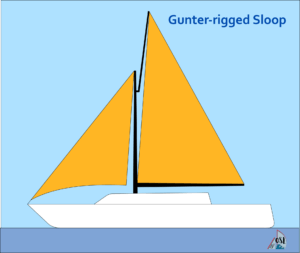
This design was popular in the 19th century because it allowed sailors to carry more sail area without having to use taller masts. However, it fell out of favor in the early 20th century when newer designs were developed that provided better performance.
Despite this, there are still some sailors who prefer the Gunter rig because of its traditional look and feel. It can also be easier to handle than some other types of rigs because the sails are smaller and lighter.
Gaff-Rigged Sloop
The gaff-rigged sloop is similar to the Gunter rig in that it uses a gaff rigged mast with an additional spar called the gaff topsail. However, it also features a headsail like the Bermuda rig.

In the past, boats commonly used gaff rigged sails, but now they have mostly been replaced by Bermuda rig sails. These newer sails are simpler than the gaff rig and allow boats to sail closer to the wind.
Spritsail Sloop
The spritsail sloop is one of the simplest rigs available. It features a single sail called the spritsail, which is attached to a spar called the sprit. This design was popular among fishermen and other working boats because it was easy to set up and maintain.

Although not as popular as before, some sailors still prefer the simplicity of a spritsail rig. It’s a great option for those who want to focus on sailing without the added complexity of multiple lines or sail plans. This type of rig is also suitable for beginner sailors and those who want an easy-to-handle boat.
The Origin of the Word Sloop
The word “sloop” is believed to have originated from the Dutch word “sloep”, which means a small boat used for fishing or transportation. The Dutch were known for their seafaring skills and had a significant influence on maritime culture in Europe during the 17th century. As such, it’s no surprise that many nautical terms used today have Dutch origins.
In fact, the sloop was initially developed in Holland during the 16th century as a small, single-masted vessel used primarily for fishing and coastal trading. These boats were highly maneuverable and could navigate shallow waters with ease, making them ideal for use in Holland’s many canals and waterways.
As Dutch sailors began to explore further afield, they brought their sloops with them, using them as auxiliary vessels to transport goods and personnel between larger ships and shore. Over time, sloops evolved into larger vessels capable of longer voyages and more extensive cargo capacity.
History of Sloops
Sloops have been a popular type of ship for centuries, with their unique rigging and hull design allowing for greater speed and maneuverability compared to other vessels. Let’s take a closer look at the history of sloops and how they have evolved over time.
17th Century: The Birth of Sloops
Sloops first emerged in the 17th century as small, fast ships used for coastal trading and piracy. Their single mast and fore-and-aft sail plan allowed them to navigate shallow waters with ease, making them ideal for smuggling goods or evading authorities. Despite their reputation as pirate ships, sloops were also used by legitimate traders due to their speed and efficiency.
18th Century: Sloops in War
In the 18th century, sloops became increasingly popular among naval forces due to their speed and agility. The British Royal Navy used sloops as dispatch vessels and reconnaissance ships during times of war. Pirates and privateers also favored sloops due to their ability to outrun larger vessels. As a result, the term “sloop-of-war” was coined to describe a small warship with a single mast and crew of around 75 men.

19th Century: Racing Sloops
The 19th century saw the rise of yacht racing, with sloops becoming a popular choice among sailors due to their versatility and ease of handling. In fact, the first recorded yacht race took place in 1826 between two sloops on the Hudson River. Sloops continued to be used for racing throughout the century, with improvements in rigging and hull design leading to faster vessels.
Modern Times: Versatile Sloops
Today, sloops are still widely used for racing and cruising due to their versatility. They are often chosen by recreational sailors who want an easy-to-handle vessel that can navigate both shallow coastal waters and open seas. Modern sloops come in various sizes, from small day-sailers to larger cruising boats. Some sloops even incorporate multiple masts, such as the ketch rig , which features a smaller mizzen mast behind the main mast.
Advantages of a Sloop
Single mast: easier to handle and maneuver.
Sloops are popular sailboats that have a single mast, which makes them easier to handle and maneuver compared to other sailboat types. The simplicity of the sloop rig means that it requires less maintenance and is generally less expensive to maintain compared to other sailboat types. With only one mast, there are fewer lines and sails to manage, making it easier for sailors who are new to sailing or those who prefer a simpler setup.
The single mast design also allows for better visibility on the water since there is no obstruction from multiple masts or rigging. This feature is especially useful when sailing in crowded waters where you need to keep an eye out for other boats or obstacles.
Faster Sailing and Closer to the Wind
Another advantage of sloops is their speed. Sloops are generally faster than other sailboat types due to their streamlined design with fewer sails. The Bermuda sloop, for example, has a triangular mainsail and one or more headsails, allowing it to move quickly through the water with minimal drag.
Sloops can also sail closer to the wind than most other sailboats. This means they can tack (sail against the wind) more efficiently, allowing them to cover more ground in less time. The ability of a sloop’s sails to be adjusted easily helps in this regard as well.
Wide Variety Available
As the most popular contemporary boat, sloops are available in a wide variety. They come in different sizes and designs suitable for various purposes such as racing, cruising, or day sailing. Some sloops even have additional sails like mizzenmast or more headsails which make them more versatile.
For instance, some sloops have a mizzenmast located aft of the mainmast which provides additional support for larger boats during heavy winds. Other sloops may have multiple headsails that allow them greater flexibility when adjusting to different wind conditions. These additional sails can make a sloop more expensive to maintain, but they also provide greater versatility and options for the sailor.
Disadvantages of a Sloop
Limited sail options in heavy weather conditions.
Sloops are known for their simplicity and ease of handling, but they have some disadvantages that sailors should be aware of. One of the biggest drawbacks is the limited sail options in heavy weather conditions. Sloops typically have a single forestay that supports the mast, which means that they can only fly one headsail at a time. This can be problematic when sailing upwind in strong winds or heavy seas.
In these conditions, it’s often necessary to reduce sail area to maintain control and prevent damage to the boat or rigging. With a sloop, this usually means taking down the headsail and relying on the mainsail alone. While this can work well in moderate wind conditions, it may not provide enough power or stability in stronger winds.
Difficulty in Handling Larger Sails Alone
Another disadvantage of sloops is that they can be difficult to handle when sailing with larger sails alone. As mentioned earlier, sloops rely on a single forestay to support the mast and headsail. When you increase the size of the sail, you also increase the load on the forestay and rigging.
This means that you may need additional crew members to help manage larger sails safely. If you’re sailing solo or with a small crew, this can make it challenging to get the most out of your boat without putting yourself at risk.
Higher Loads on Mast and Rigging Due to Single Forestay Design
The single forestay design used by sloops also puts higher loads on both the mast and rigging compared to other sailboat designs. The forestay is responsible for supporting not only the headsail but also part of the mast itself.
This means that any stress placed on the headsail or rigging will be transferred directly to the mast through this single point of attachment. Over time, this can lead to fatigue and wear on both the mast and rigging components.
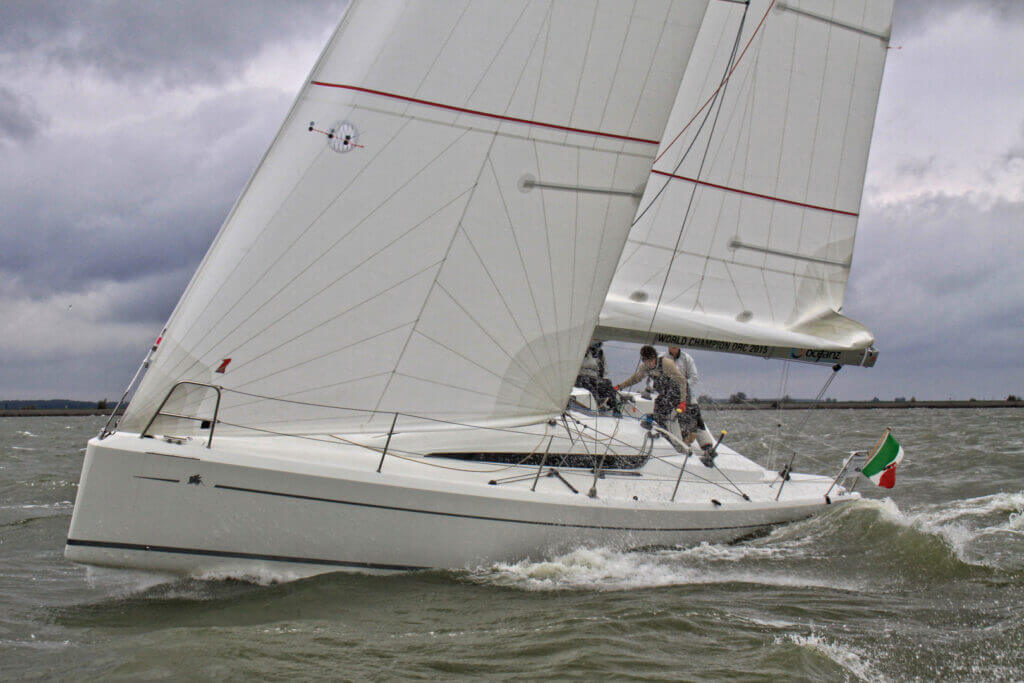
Increased Risk of Broaching in Strong Winds
Sloops are also more prone to broaching in strong winds compared to other sailboat designs. Broaching occurs when a boat is hit by a large wave or gust of wind from the side, causing it to heel over and potentially capsize.
Because sloops have a smaller cockpit and rely on a single forestay for support, they may be more susceptible to this type of event. This can be especially dangerous if you’re sailing in rough conditions or offshore where rescue may not be immediately available.
Reduced Stability Compared to Other Sailboat Designs
Another disadvantage of sloops is that they offer reduced stability compared to other sailboat designs. Sloops typically have a narrower beam and less ballast than other boats of similar size, which can make them feel less stable in heavy seas or choppy water.
This lack of stability can also affect your ability to maintain course and steer accurately, especially when sailing upwind or in challenging conditions. It’s important to understand the limitations of your boat and adjust your sailing style accordingly.
Conclusion: What is a Sloop?
With just one mast and a fore-and-aft rig, sloops are known for their simplicity and versatility. These characteristics make them an excellent choice for sailors of all levels. Whether you’re a seasoned sailor or just starting out, you’ll find that the design of a sloop allows for easy handling and maneuverability.
The single mast on a sloop is typically located towards the front of the boat. This placement provides several advantages when sailing upwind, the sail can be adjusted easily to maintain an optimal angle with respect to the wind. This is because there is only one sail to worry about, unlike other types of boats that may have multiple sails.
Similarly, when sailing downwind, a sloop’s sail can be adjusted quickly to take advantage of any changes in wind direction or speed. This flexibility makes it possible to navigate challenging weather conditions with ease.
External Links, See Also
For those looking for more technical information on sloops and other types of sailboats, the Boatdesign.net forum is an excellent resource. Here you can find discussions on everything from mast design to hull construction.
Finally, if you’re looking for some great books on sailing and sailboat design, be sure to check out “The Elements of Seamanship” by Roger C. Taylor or “Sailing Alone Around the World” by Joshua Slocum.
Similar Posts
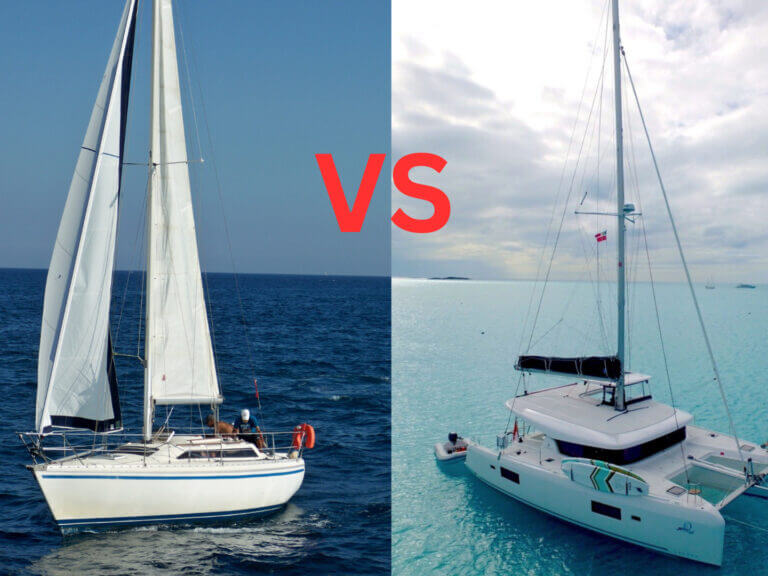
Monohulls vs. Catamarans: Which One is Best for You?
If you’re considering purchasing a sailboat, you might be wondering which type of vessel is best suited for your seafaring adventures. Fear not, for we’re here to help you weigh the differences between monohulls vs. catamarans to make an informed decision. Now, before we dive into the nitty-gritty details of hull design, sail handling, and…

How do Boats Float? Exploring the Science Behind Buoyancy
Sailboats float because the average density of the boat is less than the density of water. When boats displace as much water as it weights, this is known as the buoyancy force generated by Archimedes’ principle. If you’ve ever wondered how do boats float and therefor enable us to embark on thrilling water adventures, you’ve…

Basic Sailing Terminology: Sailboat Parts Explained
Sailing is a timeless activity that has captivated the hearts of adventurous souls for centuries. But, let’s face it, for beginners, sailing can be as intimidating as trying to navigate through a dark, labyrinthine maze with a blindfold on. The vast array of sailing terminology, sailboat parts and jargon can seem like a foreign language…

What is a Ketch Sailboat?
Ketch boats are frequently seen in certain regions and offer various advantages in terms of handling. However, what is a ketch and how does it stand out? A ketch is a sailboat with two masts. The mainmast is shorter than the mast on a sloop, and the mizzenmast aft is shorter than the mainmast. Ketches…

How Much Does Biofouling Slows Down your Boat?
Are you wondering how much biofouling can impact the performance of your sailboat? The amount of how much biofouling slows down a sailboat depends on various factors, such as the type of boat, its size, and the severity of the biofouling. On average, a sailboat with a heavily fouled hull can experience a reduction in…
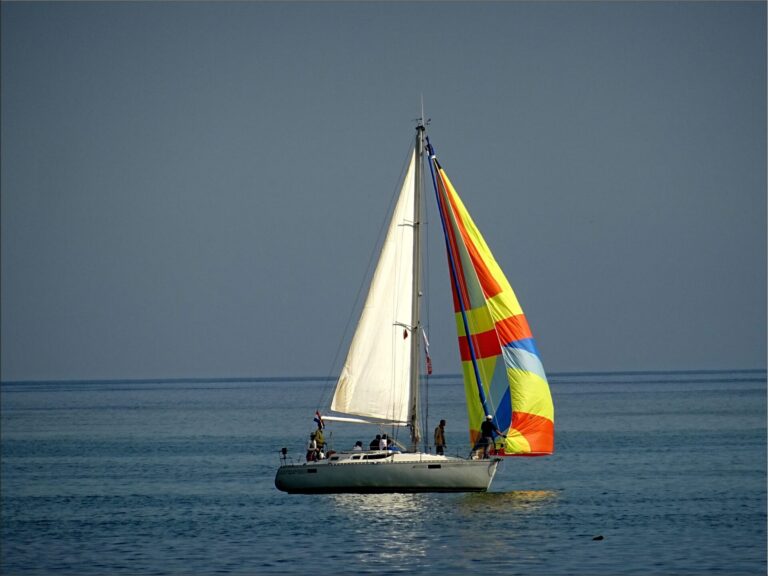
Types of Sails: A Comprehensive Guide
In the enchanting world of sailboat dynamics, where the dance between wind and water takes center stage, the significance of sails cannot be overstated. Like the wings of a bird, these meticulously crafted sails unfurl to catch the slightest whisper of breeze, converting it into a powerful forward thrust that carries us through the vast…
- Explore boats
Sloop Boats
Sloop: understanding the classic sailboat design and its history.
A sloop is a type of sailboat characterized by its single mast and fore-and-aft rigging. With a diverse range of designs and configurations, sloops have a storied history in nautical culture. They have evolved over time to include modern variations, which continue to be popular among sailors today.
Traditionally, sloops were rigged with one or more headsails and a mainsail, which could be triangular in shape or gaff-rigged. In their early days, the definition of a sloop was quite vague, with sailors customizing their rigs based on personal preferences. However, over time, the characteristics of sloops have become more defined, and today, they are among the most recognizable and widely used sailboats in both recreational and competitive sailing.
Key Takeaways
- Sloops are sailboats with a single mast and fore-and-aft rigging
- They have a diverse and storied history in nautical culture
- Modern sloops remain popular, offering versatility for sailors
Historical Background
The sloop, a single-masted sailing vessel, has a history dating back to the early 17th century. With its fore-and-aft rigging, mainsail, jib, and sometimes one or more headsails, it offered the advantages of easy handling and the ability to sail upwind. The sloop became particularly popular in the 20th century for its versatility and performance. One notable early example is the Bermuda sloop , which played a crucial role in trade between Bermuda and North America.
One historically significant variant of the sloop is the sloop-of-war , a small warship that typically mounted about 20 guns. These vessels were employed by various countries, including the United States, France, and the United Kingdom, throughout the 18th and 19th centuries. Sloops-of-war were valued for their maneuverability and speed, making them ideal for patrolling and escorting duties during times of conflict.
In the Atlantic region, sloops played an essential role in coastal trade and transportation. The Hudson River sloop , for example, was the primary means of transportation on the Hudson River from the 1600s until the arrival of affordable steamboats in the 1820s. It efficiently transported goods and people between the bustling ports of New York and Albany.
Sloops were also quite common in the state of Maine and other areas of the eastern United States. They served as versatile workhorses, carrying cargo, passengers, and providing a variety of services like fishing, coasting, and even piracy. As a result, sloops became synonymous with the economic growth and development of the region.
In conclusion, the history of the sloop showcases its importance as both a versatile sailing vessel and an essential means of transportation and commerce throughout the Atlantic region, including the United States and France. Its adaptability and performance have ensured its continued use and relevance through the centuries.
Design and Features
The sloop is a popular sailboat design known for its simplicity and versatility. In this section, we will explore the main features of a sloop, including its mast and sails, and the different rig types commonly used.
Mast and Sails
A sloop is a single-masted sailboat with a fore-and-aft rig configuration. This means that the sails are placed along the centerline of the boat, perpendicular to the mast. The sloop typically features two sails: the mainsail and the jib or headsail. The mainsail is the larger sail mounted aft of the mast, while the jib is the smaller sail situated forward of the mast. The combination of these two sails allows for efficient upwind sailing, making the sloop a versatile choice for various sailing conditions.
Bermuda Rig
The Bermuda rig is the most common type of rig used on sloops today. It is characterized by a triangular mainsail with its leading edge attached to the mast and its trailing edge, or "leech," held taut by a boom at the base of the sail. The jib, also triangular, is attached forward of the mast between the bow and the masthead. The Bermuda rig is popular for its ability to sail efficiently into the wind, its simplicity, and ease of handling, making it well-suited for a wide range of sailing activities.
Another sloop rig variation is the gaff rig, which features a four-sided mainsail supported by a spar, known as the gaff, near its upper edge. This rig allows for a larger sail area than the Bermuda rig, which can provide more power in light wind conditions. However, the gaff rig is less efficient when sailing upwind due to increased wind resistance, making it less common in modern sloop designs. While not as prevalent as the Bermuda rig, the gaff rig is still appreciated by some sailors for its traditional aesthetics and suitability for certain types of sailing experiences.
In summary, the sloop is a single-masted sailboat with a distinct design that incorporates a mainsail, a jib or headsail, and either a Bermuda or gaff rig, depending on the specific model. Its design provides an efficient, versatile, and straightforward sailing experience, making it a popular choice for many sailors around the world.
Utility and Control
Sloops are known for their versatility and ease of handling in various conditions. Their single mast and fore-and-aft rig set-up allows sailors to control the direction of the boat with greater precision. This makes sloops a popular choice among sailors for both leisure and professional purposes.
In terms of water navigation, sloops offer greater control and flexibility in their deployments. They can be used for a range of activities, such as racing, cruising, and even exploring shallow waters due to their smaller draft. The simple rig configuration also makes it easier for sailors to adjust and maneuver the sails, enabling quick responses to shifts in wind conditions or changes in course.
Control is essential when managing the various sail adjustments on a sloop. Oftentimes, sailors need to account for environmental factors such as water currents and gravitational forces. By adjusting the tension on the lines, mast position, and sail shape, sailors can effectively counteract gravity and maintain optimal control over the sloop.
In certain deployments, sloops can benefit from the added control and utility provided by advanced control loop technologies in their systems. Such technology can monitor the vessel's position in the water, identify imbalances caused by gravitational forces, and automatically adjust the sail settings to maintain balance and optimal sailing performance.
In conclusion, sloops provide a high level of utility and control for sailors across various conditions and deployments. The ability to easily adjust sails, account for gravity, and even implement advanced control loop systems makes sloops a popular and versatile option for sailing enthusiasts. With clear, concise design and sailing advantages, sloops continue to be a go-to choice for many sailors worldwide.
Sloops in Popular Culture
Sloops have also found their way into popular culture, including online games and entertainment. One example of this is the Slope game, which, although not directly related to sailboats, shares a similar name and may be inspired by the sailing world. The Slope game is a fast-paced 3D endless running game developed by Rob Kay. It challenges players to achieve a high score by navigating a constantly changing and challenging terrain.
The gameplay is intuitive and easy to learn, using just the arrow keys to control the ball's movement, making it suitable for players of all ages. Slope game can be played in full-screen mode, providing a more immersive experience and enhancing the enjoyment for players. Its simplicity and addictive nature have made it popular among casual gamers who appreciate the straightforward controls and the satisfaction of achieving higher scores.
In summary, while sloops may be best known for their sailing capabilities and historical significance, their influence extends beyond these realms. The prevalence of sloops or their nomenclature in popular culture, such as in the Slope game, demonstrates the lasting impact these sailboats have had on various aspects of entertainment.
Modern Sloops
Modern sloops have come a long way since their origins in the 17th century. They maintain their distinct fore-and-aft rig with a single mast, which is typically rigged with triangular sails, often referred to as a Bermuda rig . This configuration allows for excellent upwind performance and ease of handling, making sloops one of the most popular sailing craft in the world today.
Advancements in technology and materials have greatly improved the performance and comfort of modern sloops. Carbon fiber masts, advanced sail materials, and efficient hull designs have made these vessels lighter, faster, and more responsive. In addition to these improvements, the incorporation of modern navigation, communication, and safety systems ensures that sailors can focus more on enjoying their time on the water and less on managing complex systems.
Electric propulsion is another innovation that is gaining traction in the sailing community. Some modern sloops are designed with electric motors, eliminating the need for noisy and polluting diesel engines. These electric motors can be powered by solar panels or regenerative systems that recharge the batteries while sailing. This eco-friendly solution not only makes for a quieter and cleaner sailing experience but also reduces the overall environmental impact of the vessel.
Although sloops remain a popular choice for sailing enthusiasts, it is important to note that they are not the only option available. There are many other types of sailing craft, each with its strengths and weaknesses. Sloops, however, continue to stand out as a versatile and efficient choice for sailors of all skill levels.
In summary, modern sloops have evolved significantly from their humble beginnings, incorporating cutting-edge technology, materials, and design principles to create highly efficient and enjoyable sailing craft. With their timeless allure, versatility, and eco-friendly electric options, it is no surprise that sloops continue to be a top choice for sailors around the world.
Challenges and Solutions
Sloop is a powerful tool designed to store and visualize Kubernetes events. However, like any tool, it faces its own set of challenges. In this section, we will discuss some of these challenges and the solutions to overcome them.
Among the challenges faced by Sloop is the unpredictable nature of storms in the Kubernetes ecosystem. Storms can make it difficult to manage and monitor system performance, especially when it comes to keeping track of events. Fortunately, Sloop is specifically designed to handle such unpredictable situations. With its ability to store and display information on various Kubernetes events, Sloop helps administrators navigate through the turbulence caused by storms.
Gravity can also pose obstacles for Sloop users, as it can affect the tool's performance. Data storage and retrieval might become slower due to gravity's impact on the underlying resources. To overcome this challenge, Sloop leverages efficient algorithms and data processing techniques to minimize the effects of gravity on its performance. This ensures that users can access the necessary information quickly and reliably.
Inevitably, there will be times when Sloop users must face unexpected obstacles. Whether it's due to external factors like system upgrades or internal factors like code modifications, these obstacles can hinder the effectiveness of Sloop. To mitigate these challenges, users should remain up-to-date with the latest Sloop documentation, best practices, and system requirements. Staying informed will enable users to tackle these issues and maintain a well-functioning system.
Lastly, the process of managing Kubernetes events can be destroyed by a lack of proper planning and communication. This is especially true when dealing with complex systems that involve multiple teams and stakeholders. In response to this challenge, it is crucial for users to ensure clear and open communication channels. This may involve utilizing advanced communication tools such as supplier portals, cloud-based collaboration platforms, and real-time data sharing.
Being confident, knowledgeable, and clear when using Sloop and addressing challenges will ultimately lead to a better management of Kubernetes events. By addressing these challenges head-on and incorporating necessary solutions, users can harness the full potential of Sloop in managing and monitoring their Kubernetes ecosystems.
A sloop is a type of sailing vessel characterized by its single mast and two sails, typically a mainsail and a headsail. The simplicity of this rigging makes it a popular choice for both recreational and racing sailors. We will now explore some important terms related to sloops – their design and operation – with a confident, knowledgeable, neutral, and clear tone.
Stern : The stern is the rear or aft part of a sloop or any other boat. It plays a crucial role in the overall stability and maneuverability of the vessel. On a sloop, the lines running from the mast to the stern help control the mainsail.
Draft : The draft of a sloop refers to the vertical distance between the waterline and the lowest part of the boat, usually the keel. Draft determines the minimum water depth necessary for a sloop to operate without running aground. A shallow draft enables a sloop to sail in shallower waters, whereas a deeper draft improves stability and windward performance.
Range : In nautical terms, the range refers to the distance a sloop or any other vessel can travel without refueling or resupplying. As sloops typically rely on wind power for propulsion, their range is primarily limited by factors such as crew endurance, provisions, and the availability of suitable wind conditions.
In addition to these terms, it is essential to understand some basic sloop components and their functions:
- Mast : The mast is the vertical support structure for the sails on a sloop. On a sloop, there is only one mast, set about one-third of the boat's length aft of the bow.
- Mainsail : The mainsail is the primary and largest sail on a sloop. It is attached to the mast and the boom, a horizontal spar extending from the mast.
- Headsail : The headsail, also known as the jib or genoa, is the second sail on a sloop, hoisted to the top of the mast on the forestay. It contributes to the boat's forward propulsion and helps with maneuvering.
A dictionary definition of a sloop would be: "a fore-and-aft rigged boat with one mast and a single jib." This concise definition captures the essential characteristics of a sloop, making it a valuable starting point for delving deeper into the world of sailing and nautical terminology.
Frequently Asked Questions
What is the main difference between a sloop and a ketch.
The main difference between a sloop and a ketch lies in the sail configuration. A sloop features a single mast with a mainsail and a headsail (typically a jib), while a ketch has two masts: a taller main mast and a shorter mizzen mast situated aft of the main mast. The ketch has additional sails, including the mizzen sail, which provides more sail area and better sail balance.
How does a sloop differ from a schooner?
Sloops and schooners both have distinct sail configurations. A sloop is characterized by a single mast with a mainsail and a headsail, whereas a schooner has two or more masts, with the aft mast (the one furthest back) being taller or of similar height to the forward mast. Schooners generally have more sail area than sloops, making them more suited for long-distance sailing and cargo transport.
What are the advantages of a sloop over a cutter?
The main advantage of a sloop over a cutter is its simplicity and ease of handling. Sloops have a single headsail, whereas cutters feature two or more headsails. This simplicity makes sloops easier to sail, especially for single-handed sailors or small crews. Additionally, sloops typically have more effective upwind performance than cutters due to their cleaner airflow around the sails.
Are sloops suitable for long-term living aboard?
Sloops can be suitable for long-term living aboard, depending on the size and layout of the boat. Many modern sloops are designed with comfortable accommodations, including cabins, galley, and head facilities, making them ideal for extended cruising or liveaboard situations. However, individual preferences and needs may vary, so it's essential to evaluate each boat on a case-by-case basis.
What is the expected size range for a sloop?
Sloops come in various sizes, from small daysailers to larger yachts. Typically, sloop length can range from 20 to 60 feet or more. Smaller sloops are popular choices for daysailing and weekend cruising, while larger sloops offer more space and amenities for long-term voyages or living aboard.
How does a sloop perform in Sea of Thieves?
In the popular video game Sea of Thieves, the sloop is the smallest and most maneuverable ship, ideal for one to two players. It features a single mast with two sails: a main and a smaller headsail. Due to its size and maneuverability, the sloop is an excellent choice for quick getaways and tight spaces, giving players an advantage when evading larger ships or navigating through treacherous waters.
Specifications
Sloop boats for sale.

Listing Coming Soon

Featured Brands

All Brands for Sloop Boats
- Black Workboats
- Enkhuizensloep
- Grand Soleil
- Hallberg-Rassy
- Hans Christian
- Island Packet
- Jan Van Gent
- Langweerder Sloep
- Nautor Swan
- Oud Huijzer
- Perini Navi
- Reddingssloep
- Silver Yachts
- Sweden Yachts
Related Types

Freshwater Fishing
Related articles.

Where is Haulover Inlet: Your Quick Guide to Finding It
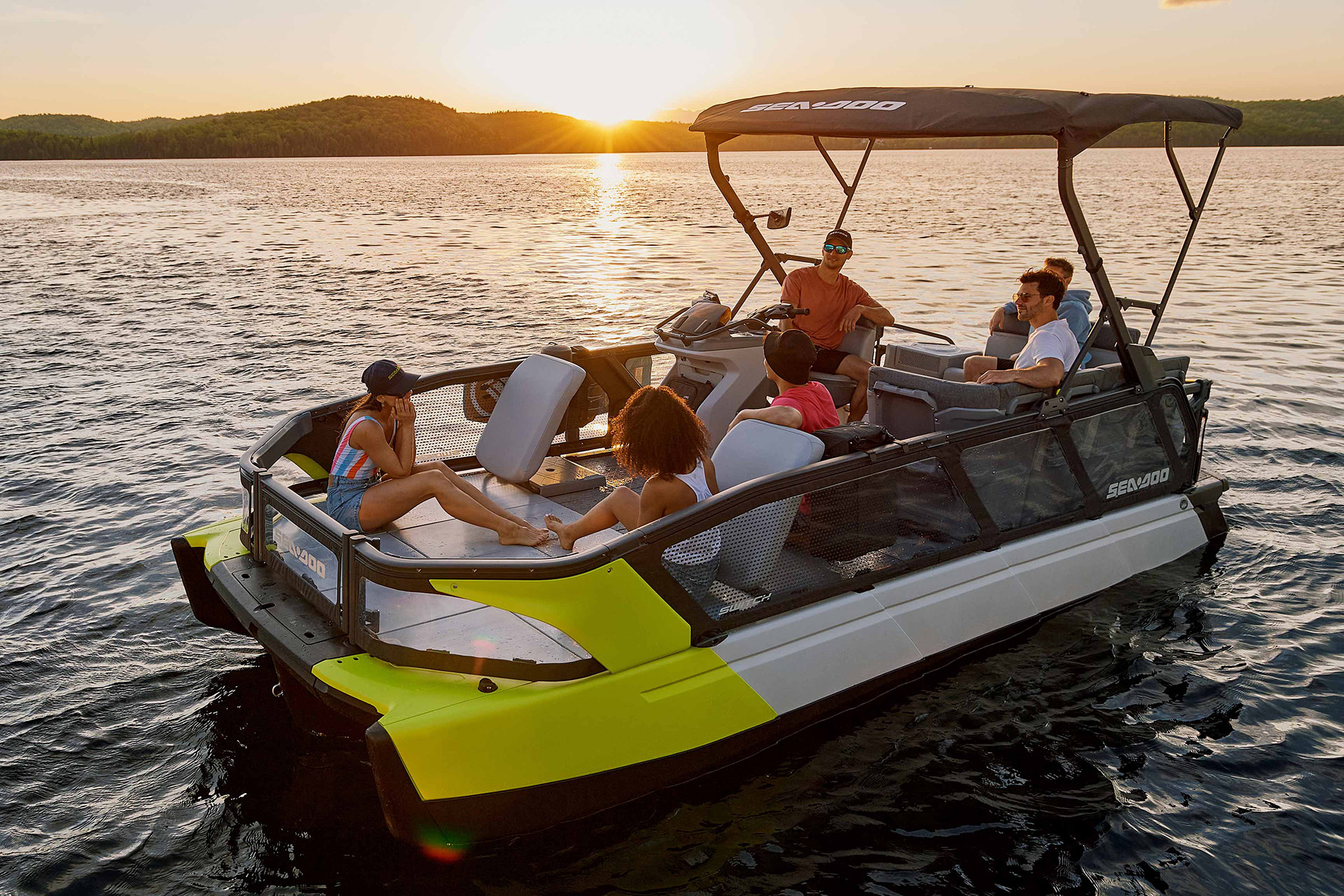
2024 Sea-Doo Switch Ultimate Guide: Mastering Your Next Water Adventureswitch

Big Pass Sarasota: A Hidden Gem for Thrill-Seeking Boaters

Tobin Sports Inflatable Boat: A Comprehensive Review
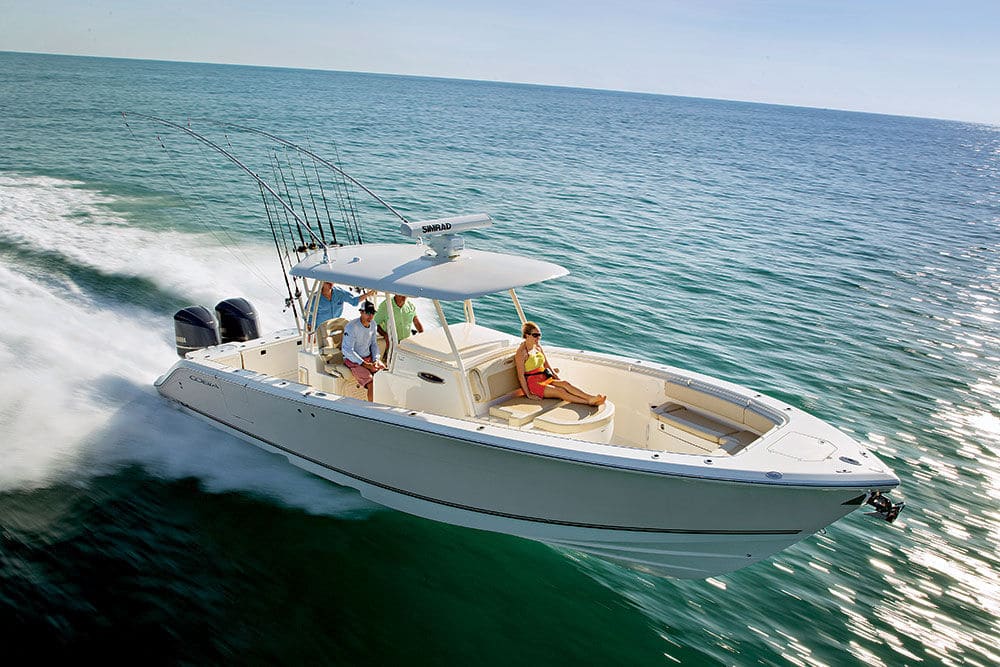
Center Console Boats-Ultimate Guide: Expert Tips and Essentials
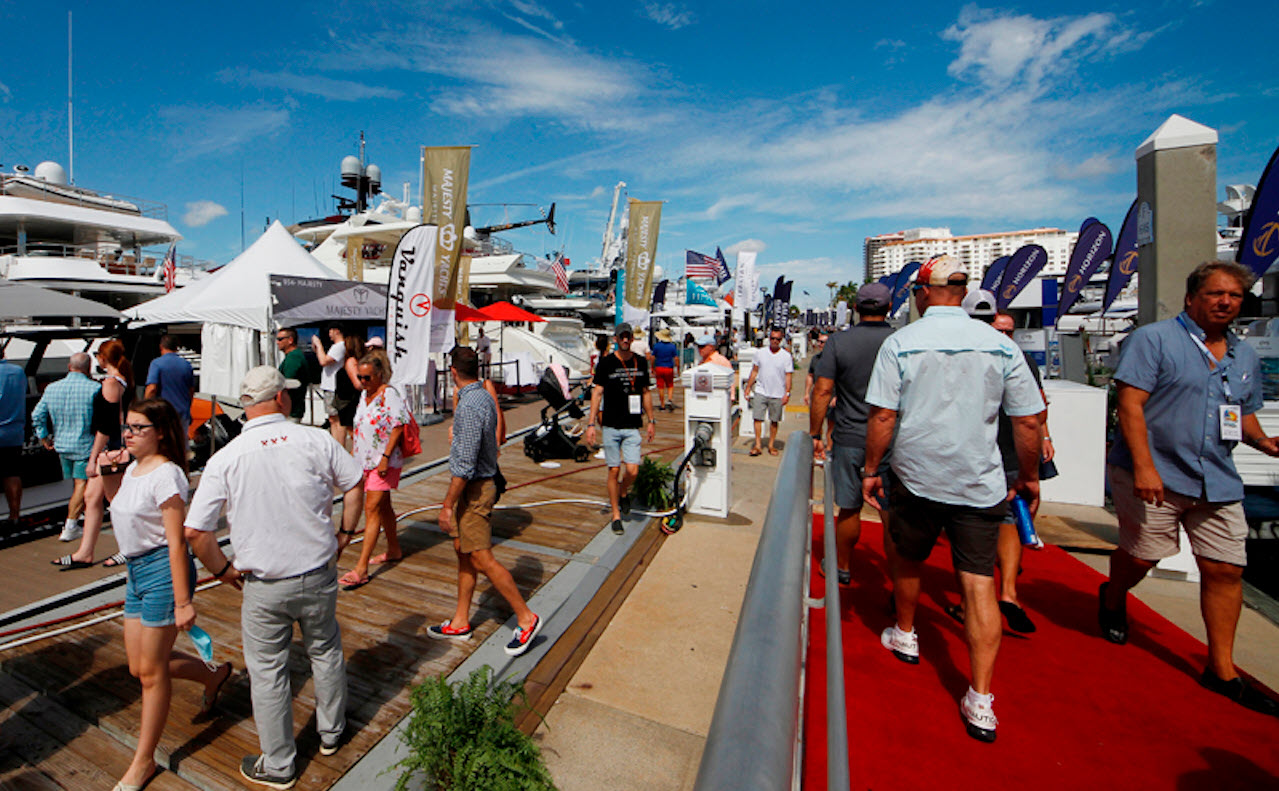

Top 5 Boat Dealers Kentucky: Best Places to Buy or Lease a Boat

Sebastian Inlet Webcam: Live Beach Views and Surf Conditions

Black Point Marina: Your Comprehensive Guide to Boating Bliss

- News & Views
- Boats & Gear
- Lunacy Report
- Techniques & Tactics
CRUISING SAILBOAT RIGS: Sloops, Cutters, and Solent Rigs
In our previous episode in this series we discussed what I like to call split rigs–ketches, yawls, and schooners–where a sailplan is divided among two or more masts. Cruising sailors once upon a time preferred such rigs, at least on larger cruising boats, because each separate sail requiring handling was smaller and thus more manageable. These days, however, by far the most popular rig for both racing and cruising sailboats is the simple sloop rig. This has a single mast supporting a single Marconi mainsail with a single headsail supported by a single headstay flying forward of it.
Its advantages are manifest: there are only two sails for the crew to handle, each of which can be hoisted with a single halyard and trimmed with a single sheet. While sailing, there are normally only two lines–the jib sheet and mainsheet–that need to be controlled at any given moment. And because there is but one headsail flying forward of the main, tacking a sloop is easy, since the headsail, even if it is a large overlapping genoa, can pass easily through the open foretriangle.
Sloop rigs are highly efficient to windward, thanks to the so-called “slot effect” created by the interaction of the mainsail and headsail. How this actually works is a matter of some debate. The traditional theory is that airflow in the narrow slot between the sails is accelerated, which decreases air pressure on the leeward side of the mainsail, thus increasing the lift the sail generates.
The revisionist theory is that air deflected from the headsail actually works to decrease airflow in the slot, increasing pressure on the windward side of the headsail, thus increasing the lift it generates. Since increasing the lift generated by one sail seems to necessarily decrease that generated by the other, others believe a single Marconi sail must be just as aerodynamic, if not more so, than two sails. This last proposition, however, is contradicted by real-world experience, as no one has yet created a single-sail rig that is as fast and closewinded as a double-sail sloop rig.
The almighty slot in action. Its effects are salubrious, but no one can really explain why
The primary disadvantage of a sloop rig is that the sails must be relatively large. They are therefore harder to handle in that they are heavier (making them harder to hoist) and generate larger loads when flying. Much of this difficulty, however, is obviated by modern winches and roller-furling gear, which is why sloop rigs are now so popular, and deservedly so. In light to moderate sailing conditions, which is what most sailors normally encounter, a sloop is by far the fastest, most easily handled rig currently available.
In heavier conditions sloops do present some challenges. To reduce sail area forward of the mast, if the headsail is hanked on to the headstay, which was the traditional practice, you must change the sail for a smaller one. This requires crew to work for extended periods on the bow of the boat, where conditions can get wild and wet. If the headsail is on a modern roller-furler, the sail can be easily roller-reefed from the cockpit, but past a certain point a roller-reefed headsail’s shape becomes inefficient. You either must live with this or unroll the sail and change it for another smaller one. The stronger the wind gets, the more distorted the roller-reefed sail becomes, and the more important it is to change it. Changing a sail on a furler in a strong wind, however, is an awful chore. The very first thing you must do (unroll the sail) greatly increases sail area right when you most want to decrease it. Then you must somehow control a large headsail as it comes off a furling rod with its luff unrestrained in strong wind.
Coastal cruisers are never likely to sail in strong conditions for very long. On the few brief occasions their boats are pressed hard they are normally willing to limp along on an ugly scrap of roller-reefed genoa. They are also more likely to have to short-tack their boats in confined areas, thus the ease of tacking a sloop makes it the rig of choice on coastal boats. Bluewater cruisers, on the other hand, may sail in strong weather for days on end, so there are advantages to cutting up the sail area in the foretriangle into smaller more manageable pieces. Bluewater cruisers traditionally therefore often prefer a cutter rig, which has a single mast and a headstay like a sloop, but also an inner forestay behind the headstay from which a smaller intermediate staysail can be flown.
Modern cutter-rigged cruiser sailing under a staysail and a reefed mainsail
The big advantage of a cutter rig is that in a big blow the jib on the headstay can come right off (or be rolled up) and the smaller staysail can carry on alone, more inboard and lower in the rig, where it balances better against the reduced area of a deeply reefed mainsail. Cutters are also efficient to windward, though some claim they are not as efficient as sloops. Personally, I’ve found cutters are sometimes actually more closewinded than sloops, at least in moderate to strong winds, as the sheeting angles on a pair of smaller, flatter headsails can be narrower than the angle on one larger, more full-bodied sail. In very heavy conditions, with just a staysail and reefed mainsail deployed, I believe a cutter is almost always more efficient to windward than a sloop.
On anything from a beam reach to a tight closehauled angle, a cutter can also fly both its headsails unobstructed. Sailing on a broad reach, however, the staysail blocks air from reaching the jib, reducing the rig’s effective sail area just when the decrease in apparent wind speed caused by the wind blowing from behind the boat demands that sail area instead be increased. Another problem is that a cutter requires extra standing rigging–not only the inner forestay, but also, very often, either an extra set of swept-back aft shrouds or a pair of running backstays to help support the inner forestay from behind. This adds complexity and increases rig weight well above the deck.
The biggest disadvantage of a cutter rig is that there are two headsails to tack (or jibe) across the boat instead of just one. There is an extra set of sheets to handle, plus the jib quarrels with the inner forestay every time it comes across the foretriangle. This is less of a problem if the jib is small and high-cut (these are called yankee jibs) so that it slips more easily through the narrow gap between the inner forestay and headstay. When flying a large genoa, however, crew must often go forward to help horse the sail around the inner forestay. If you don’t have enough crew for this, you may have to roll up part of the genoa (assuming it’s on a roller-furler) before tacking or jibing and unroll it again afterward, which is a bother. Also, if the wind grows strong again, but not so strong that you can sail on the staysail alone, you either have to change your genoa for a smaller sail or roller-reef it into an inefficient shape, which is (theoretically) precisely the conundrum that drove you to favor a cutter rig in the first place.
On a true cutter specifically designed to accommodate a staysail, the mast is usually farther aft than it would be on a sloop and/or there is a bowsprit to enlarge the foretriangle. This allows for a larger, more useful staysail and should enlarge the gap between the headstay and inner forestay so a jib can tack through more easily. A larger foretriangle also allows the jib to be larger without overlapping the mainsail, but a big overlapping genoa will still present problems when tacking or jibing.
A “true” cutter under sail. With the mast aft the foretriangle is bigger, which allows for a bigger, more useful staysail. As on this boat, a true cutter often flies a high-cut yankee jib forward of the staysail
The staysail can also be made club-footed with its own boom. Such a spar, known as a jib-boom, can be controlled by a single sheet that need not be adjusted when tacking. When short-tacking in enough breeze for the boat to sail under main and staysail alone this is the height of convenience. You can shift the helm back and forth without ever touching a line. A jib-boom, however, unless sheeted tight, will flail about the foredeck whenever its sail is luffing while being hoisted, doused, or reefed. It may harm crew on the foredeck during an accidental jibe, as it can sweep suddenly across the boat with some force unless restrained by a preventer.
A cutter-rigged cruiser with a club-footed staysail
Bear in mind, too, that enlarging the foretriangle, particularly on a boat without a bowsprit, usually means mainsail area must be reduced commensurately. In many cases the mainsail is then too small and/or too far aft for the boat to sail and maneuver under main alone. When attempting to dock, anchor, or moor under sail this can be a significant disadvantage. (Note, however, that many sloops are also often unable to maneuver under mainsail alone.)
One variation increasingly popular with bluewater cruisers is a sloop/cutter hybrid, sometimes called a slutter rig, where a removeable inner forestay is installed on what would otherwise be a straight sloop rig. The removable stay normally has some sort of quick-release mechanism at deck level that makes it easy to set up and tension the stay and to loosen and remove it. When stowed, the removeable stay is brought aft to the mast and secured.
Example of an inner forestay with a retro-fitted inner forestay with a quick-release fitting that allows the stay to be moved out of the way when desired
To a large extent, the slutter rig does offer the best of both worlds. In light to moderate winds you can stow the inner forestay and sail the boat as a straight sloop with one large genoa passing through an open foretriangle. In heavy conditions, you can set up the inner forestay, hank on a staysail, roll up or douse the large genoa, and sail the boat under main and staysail alone. Since setting up an inner forestay and hanking on a staysail is normally less taxing than stripping a large genoa off a furling rod and hoisting a smaller working jib and/or storm sail in its place, this is a viable practice.
Sometimes you see true cutters that have been converted to slutters. Here the foretriangle is normally large enough to fly two headsails simultaneously if desired, which is often not possible on a converted sloop. The downside to this arrangement is that making the inner forestay removable makes it impossible to install either a roller-furling staysail (currently a popular arrangement on cutter rigs) or a club-footed staysail.
Another variation that has appeared more recently is the so-called solent rig, where a solent stay is installed directly behind a boat’s headstay. The headstay carries a big genoa (usually on a roller-furler) that is flown in light to moderate wind, and the solent stay carries what is effectively a smaller working jib (or a “blade jib,” as some like to call them now) to fly in stronger conditions. The solent jib (which is normally larger than a staysail) can be rigged permanently on its own roller-furler, or it can be on a removable stay, as is seen on slutters and some cutter rigs.
The huge problem with a permanent solent rig is that the genoa forward on the headstay is normally so close to the solent stay that it cannot be pulled through the gap between the stays, but must be entirely rolled up and unfurled again every time the boat is tacked. In some cases the solent stay actually isn’t terribly close to the headstay, but still the top of the stay is always very close to the top of the headstay and tacking is thus always problematic. For this reason, personally, I strongly favor removable solent stays.
Typical solent rig with the two stays quite close together
On this example, the two stays are farther apart, until you get up to the masthead
One recent innovation that has made the handling of removable sails much easier are sails with torque-rope luffs that are mounted on continuous-line furlers. These were developed first on shorthanded ocean-racing boats, but are now leaking on to cruising boats with increasing frequency. For these to work the sail must usually be a lighter laminated sail rather than straight Dacron. A length of high-modulus rope especially designed to resist twisting, a torque rope so called, is sewn into the luff of the sail, which is then mounted on a removable lightweight continuous-line furling drum. Once the sail is hoisted with its torque rope tensioned it can be furled up on its own luff. It can also be taken down and stowed in a bag this way, all rolled up on itself. And it can be hoisted again while still rolled up. Handling the sail is thus very easy, as the only time it is unrolled and flying free is when you are actually flying it.
The great flexibility of a torque-rope sail actually gives you two different options if you are trying to create a solent rig. The smaller solent sail can be made a removable torque-rope sail, in which case you will be setting and flying it inside the headstay. Or you can keep a small working jib on your headstay and set up a larger removable genoa-size torque-rope sail forward of it. Sails like this have all sorts of names–Code Zero sails, screechers, gennakers, etc. The most important thing, if you are ordering one, is not what you call it, but rather that it is cut flat enough to sail efficiently to windward. Also, when flying such a sail you’ll need some sort of bowsprit forward of your headstay to carry it, and the sprit must be strong enough to carry the rig’s full headstay load when the sail flying.
The headsail arrangement on my cutter-rigged boat Lunacy . A triple-headsail sloop you might call it. The headstay and the inner forestay are permanently rigged. The screecher, as I call it, flies on its own luff forward of the headstay and is controlled with a removable continuous-line furler. The bowsprit and the plate under it were added to carry the big load the sail generates. When the screecher is flying the headstay goes slack and the screecher’s torque rope is what’s holding up the front of the mast
An IMOCA Open 60 flying a staysail on a continuous-line furler
A continuous-line furler up close and personal, removed from the rig with sail furled
Yet another option is to make the staysail in a cutter rig a removable torque-rope sail. I have seen these on shorthanded racing boats, but never on a cruising boat. I wonder sometimes if I should try it on my boat. If anyone has tried it on their boat, I do wish they would get in touch!
Related Posts

NICK SKEATES ON WYLO II: The Ultimate Barebones Cruiser and his Ultimate Dirt Simple Boat

NORTHBOUND LUNACY: Atlantic City, NJ, to Portland, ME
My last two boats–a Bristol 39 and a Warwick 47–have been sloops with inner forestays. The present Warwick has a r/f forstaysail so it’/s more or less permanent. This is a great heavy weather and offshore rig–perfect for the ocean and he Caribbean, the Med not so much. The forestayail is pretty small so it takes a considerable blow to make it the right choice.
Go easy on the torque rope idea unless a) the mast is beefed up for it b) the winches, lead blocks and the deck under the winch base on which the halyard lays are beefed up. You need to plan on having a halyard lock for the top of the torque rope AND a robust purchase to load the bottom end. THIS is how the race boats are set up Coop
Leave a Reply Cancel Reply
Save my name, email, and website in this browser for the next time I comment.
Please enable the javascript to submit this form

Recent Posts
- BAYESIAN TRAGEDY: An Evil Revenge Plot or Divine Justice???
- MAINTENANCE & SUCH: July 4 Maine Coast Mini-Cruz
- SAILGP 2024 NEW YORK: Lifestyles of the Rich and Famous
- MAPTATTOO NAV TABLET: Heavy-Duty All-Weather Cockpit Plotter
- DEAD GUY: Bill Butler
Recent Comments
- Gweilo on SWAN 48 SALVAGE ATTEMPT: Matt Rutherford Almost Got Ripped Off! (IMHO)
- Alvermann on The Legend of Plumbelly
- Charles Doane on BAYESIAN TRAGEDY: An Evil Revenge Plot or Divine Justice???
- Nick on BAYESIAN TRAGEDY: An Evil Revenge Plot or Divine Justice???
- jim on BAYESIAN TRAGEDY: An Evil Revenge Plot or Divine Justice???
- August 2024
- January 2024
- December 2023
- November 2023
- October 2023
- September 2023
- August 2023
- February 2023
- January 2023
- December 2022
- November 2022
- September 2022
- August 2022
- February 2022
- January 2022
- December 2021
- November 2021
- October 2021
- September 2021
- February 2021
- January 2021
- December 2020
- November 2020
- October 2020
- September 2020
- August 2020
- February 2020
- January 2020
- December 2019
- November 2019
- October 2019
- September 2019
- August 2019
- January 2019
- December 2018
- November 2018
- October 2018
- September 2018
- August 2018
- February 2018
- January 2018
- December 2017
- November 2017
- October 2017
- September 2017
- August 2017
- February 2017
- January 2017
- December 2016
- November 2016
- October 2016
- September 2016
- August 2016
- February 2016
- January 2016
- December 2015
- November 2015
- October 2015
- September 2015
- August 2015
- February 2015
- January 2015
- December 2014
- November 2014
- October 2014
- September 2014
- August 2014
- February 2014
- January 2014
- December 2013
- November 2013
- October 2013
- September 2013
- August 2013
- February 2013
- January 2013
- December 2012
- November 2012
- October 2012
- September 2012
- August 2012
- February 2012
- January 2012
- December 2011
- November 2011
- October 2011
- September 2011
- August 2011
- February 2011
- January 2011
- December 2010
- November 2010
- October 2010
- September 2010
- August 2010
- February 2010
- January 2010
- December 2009
- October 2009
- Boats & Gear
- News & Views
- Techniques & Tactics
- The Lunacy Report
- Uncategorized
- Unsorted comments
- Types of Sailboats
- Parts of a Sailboat
- Cruising Boats
- Small Sailboats
- Design Basics
- Sailboats under 30'
- Sailboats 30'-35
- Sailboats 35'-40'
- Sailboats 40'-45'
- Sailboats 45'-50'
- Sailboats 50'-55'
- Sailboats over 55'
- Masts & Spars
- Knots, Bends & Hitches
- The 12v Energy Equation
- Electronics & Instrumentation
- Build Your Own Boat
- Buying a Used Boat
- Choosing Accessories
- Living on a Boat
- Cruising Offshore
- Sailing in the Caribbean
- Anchoring Skills
- Sailing Authors & Their Writings
- Mary's Journal
- Nautical Terms
- Cruising Sailboats for Sale
- List your Boat for Sale Here!
- Used Sailing Equipment for Sale
- Sell Your Unwanted Gear
- Sailing eBooks: Download them here!
- Your Sailboats
- Your Sailing Stories
- Your Fishing Stories
- Advertising
- What's New?
- Chartering a Sailboat
- Sailing Sloop
Is a Sailing Sloop the Best Rig for Cruising?
For ultimate windward performance, nothing beats a deep-fin keeled sailing sloop with a tall, high aspect ratio Bermuda rig (also known as a Marconi rig).
Low aspect ratio sails are short and squat while high aspect ones are tall and narrow, or long and narrow like the wings on a high-performance sailplane.
But unlike sailplanes - which, being unrestrained by land or water, are always heading directly into the apparent wind - we sailors aren't always beating to windward.
In fact most of us go to some lengths to avoid it if we can.
High Aspect Ratio Sloop Rig
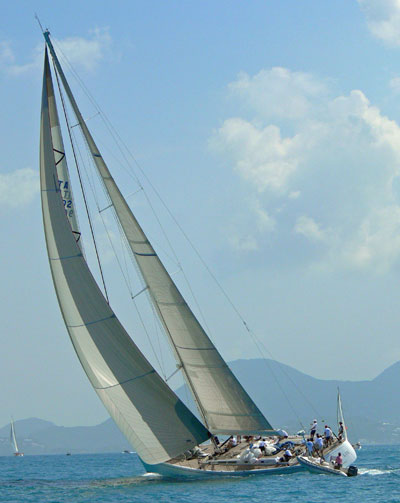
Very high aspect ratio sloop rigs like the one shown above are only really appropriate for racing sailboats, where windward performance is vital for success.
Such rigs rapidly lose their efficiency when even slightly off the wind, which is why successful racing sailboats carry an extensive sail wardrobe with sails to cater for all conditions.
This is a route we cruising sailboaters don't want to go down, so the extreme versions of sloops aren't for the likes of us, particularly as we may have difficulty of getting eight crew members to sit out when going to windward...
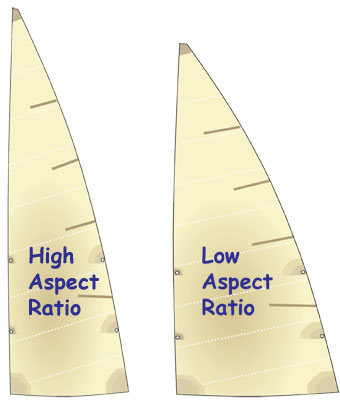
Sailing sloops with moderate rigs though, are probably the most popular of all cruising sailboats.
With just a single mast, two sails (a foresail or headsail, and a mainsail) and the minimum of rigging and sail control lines they are relatively simple to operate and less expensive than two-masted ketch rigs.
There are two sailing sloop variants - masthead rigs and fractional rigs.
Masthead Rigged Sailing Sloops
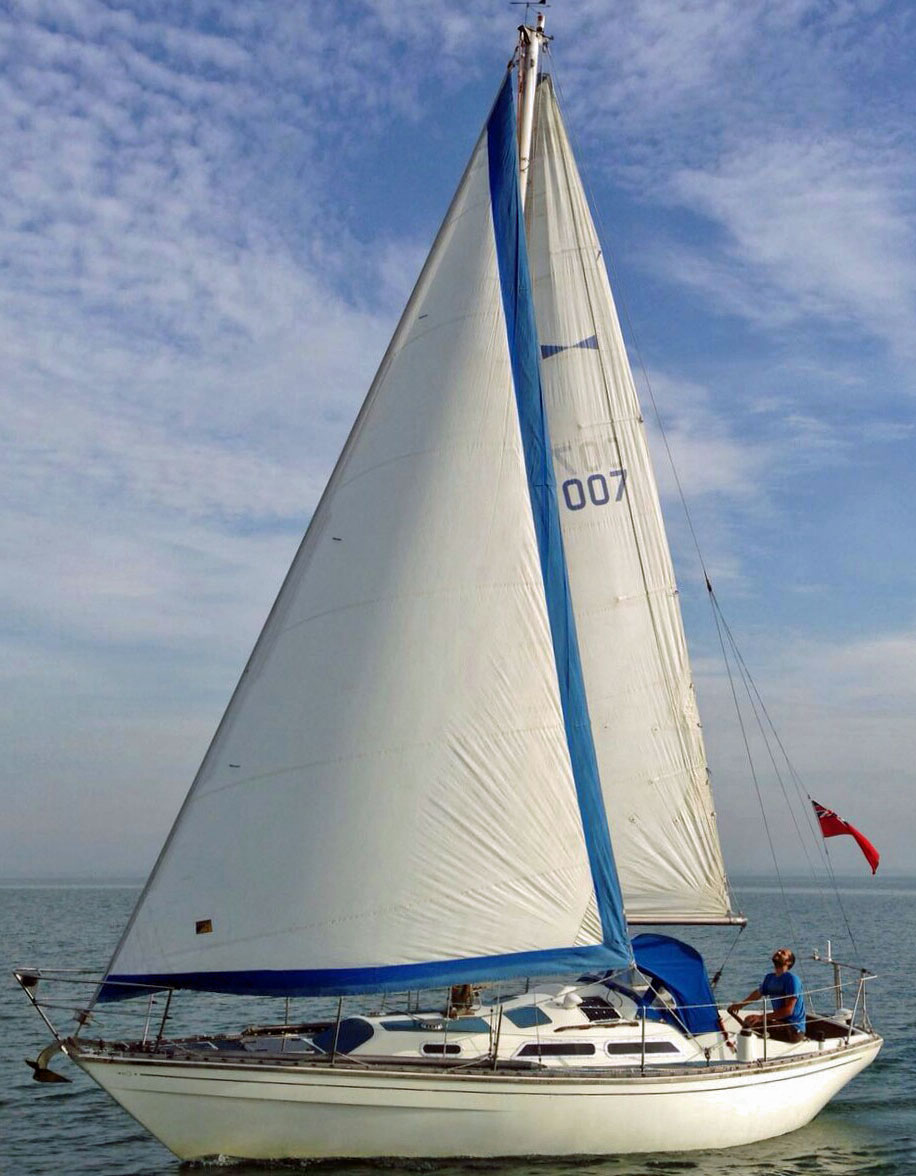
The masthead sloop is the simpler rig of the two, with the forestay attached at the top of the mast. Foresails of various sizes can be set on the forestay, from small 'working' jibs through to large 130% deck-sweeping genoas.
Incidentally, foresails are called jibs if the clew of the sail doesn't reach farther aft than the mast and genoas when it does. So the 'luff perpendicular' of a 130% genoa is 30% longer than the distance between the mast and the stemhead - known as the 'J' measurement.
Deck-sweeping genoas such as these create a wide blind-spot off the leeward bow. Unwanted surprises and chance encounters will be far fewer if the clew is cut higher, providing forward visibility from the cockpit under the foot of the sail.
Nowadays however, the headsail is set on a furling gear, with the mainsail being either slab-reefed or equipped with in-mast or in-boom furling gear .
The Double-Headed Masthead Rig
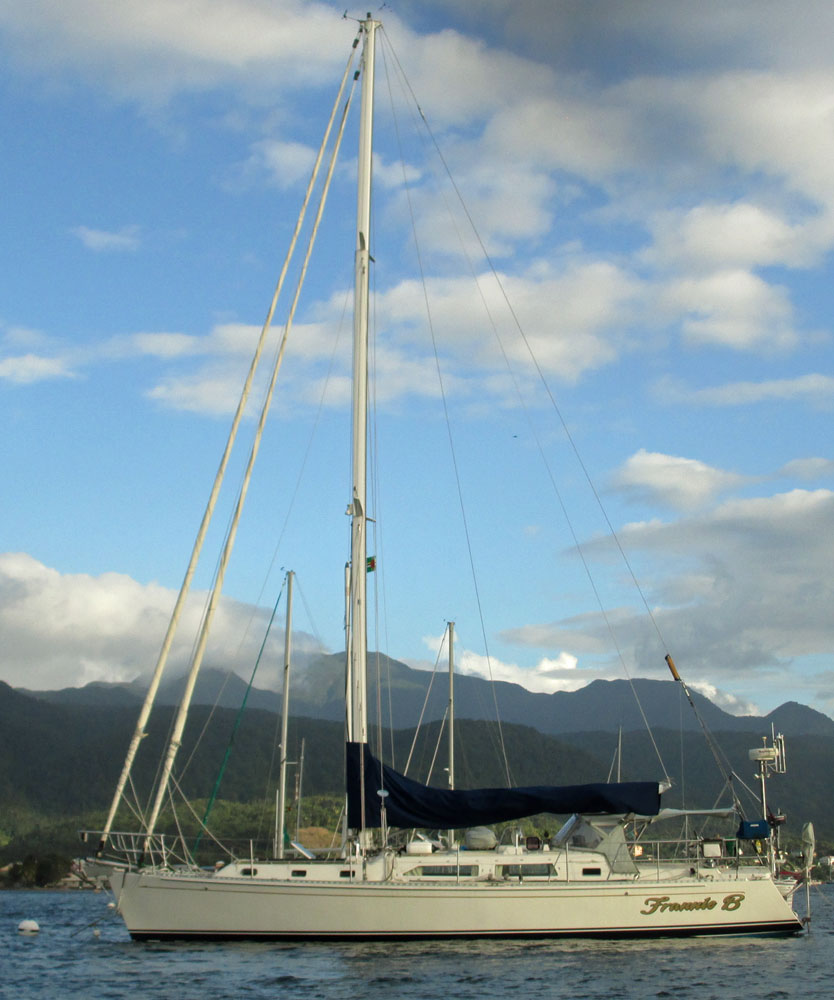
Also known as the Solent Rig , this arrangement shouldn't be confused with the cutter rig, where both foresails (a high-cut yankee and a staysail) can be set at the same time. With the double headed rig it's one or the other.
The foremost sail will be the larger of the two - often a 150% genoa - and the other perhaps a jib that just fills the fore-triangle.
With the larger sail set, it must be furled before tacking and only unfurled when the on the other tack.
Few boats come off the production line with the double headsail rig in place but it can be retro-fitted on some boats - and this article from Sail Magazine shows how...
Fractionally Rigged Sailing Sloops
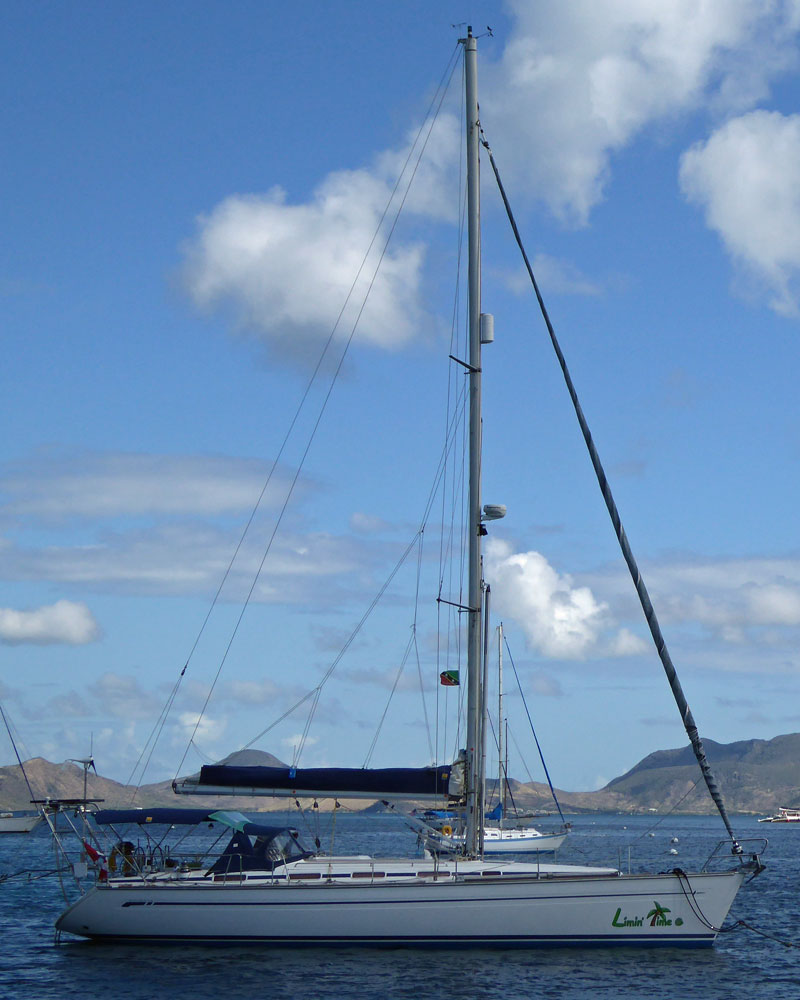
With the fractional rig the forestay is attached at a point further down the mast, leaving the top section of the mast unsupported from forward. To maintain sail area the smaller jib is compensated by a larger main, which provides the following benefits:
- In rising winds the largest and most powerful sail is usually reefed first. On a fractional rig this is the mainsail. It's much easier and quicker to reef the mainsail than change the jib - though that's not the case if you have a sailing sloop with a roller reefing headsail .
- With the shorter hoist spinnakers are smaller and easier to control than the larger ones flown on masthead sloops.
- Downwind the larger main gives more drive, and it's not so important if the smaller jib is blanketed by it.
- By tensioning the backstay, the mast is deflected forward in the middle sections, flattening the mainsail, and thus maintaining drive whilst reducing heeling moment.
And of course there are downsides. The primary one is the requirement for running backstays to tension the forestay and keep the mast in column. These must be properly handled during tacking and jibing or you risk damaging, or even losing, the mast.
A Heavy Weather Refinement
All offshore sloops should have the capability of rigging a temporary inner forestay for hanking on a storm jib. Set on the 'outer' forestay a storm jib can cause lee helm, which is really what you don't want in heavy weather.
The inner stay is stored against the mast when not in use, and deployed by attaching to a strongpoint on the foredeck using one of the several tensioning devices designed for this purpose.
Examples of Sloop Rigged Cruising Sailboats...
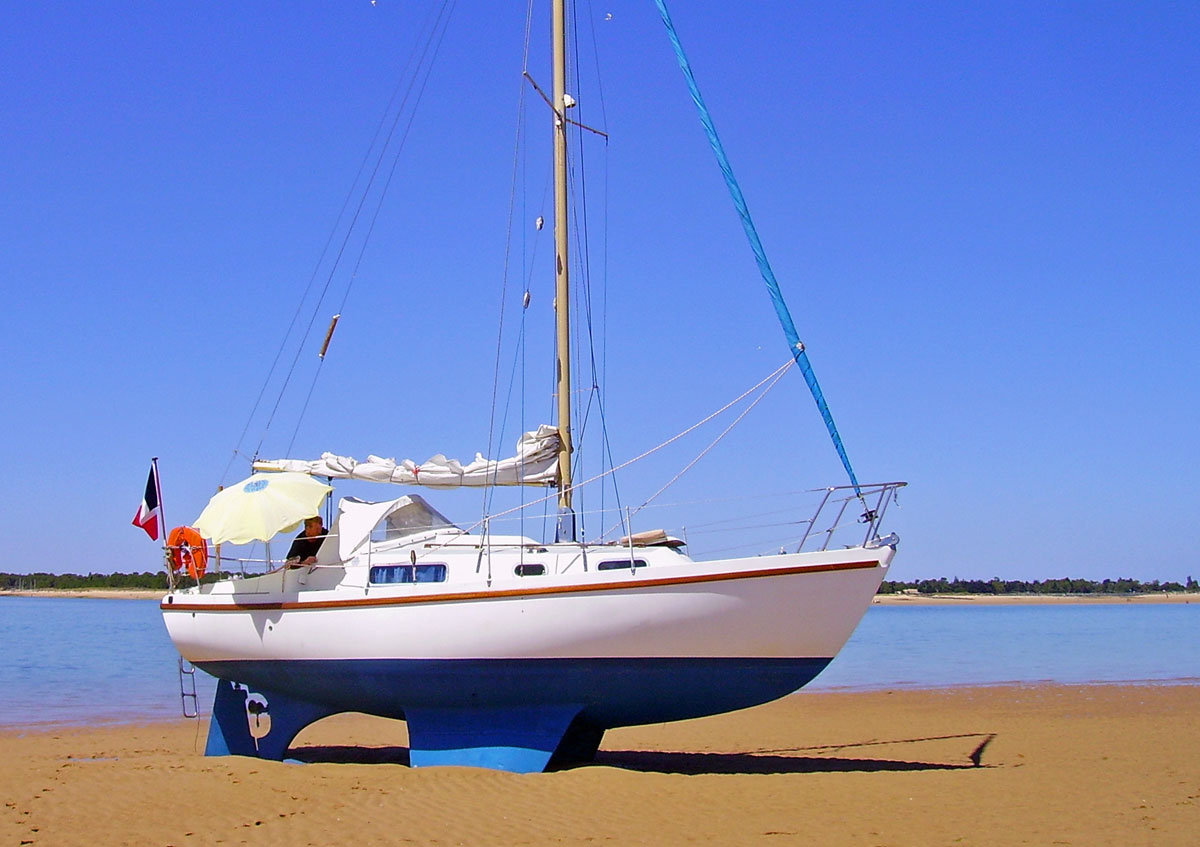
Other popular rigs for cruising offshore...
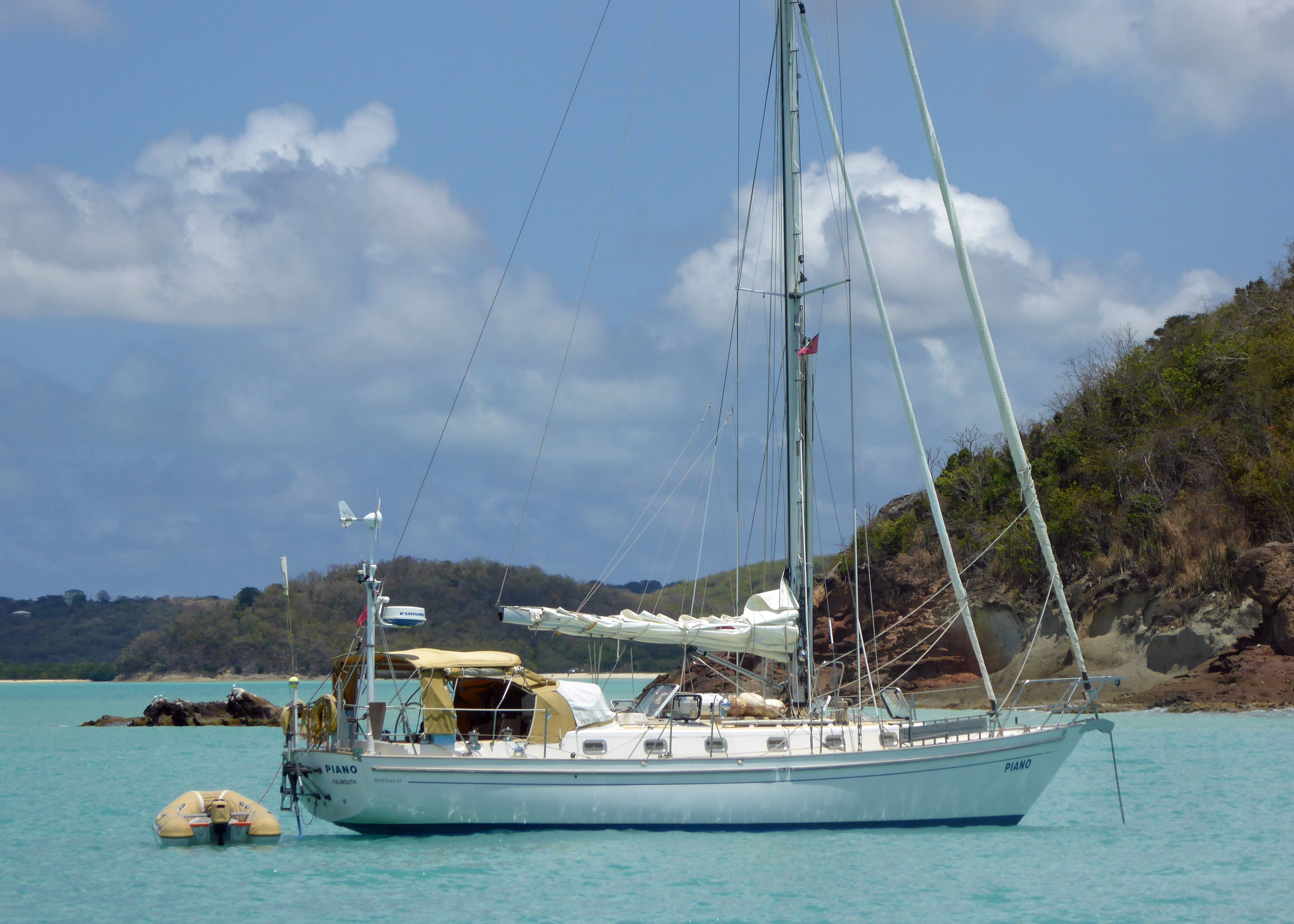
Is the Cutter Rig Superior to the Solent Rig for Offshore Cruising?
Both the cutter rig and the solent rig provide the offshore skipper with a choice of foresails to fly, but there the similarity ends. So what's the difference between these two rigs?
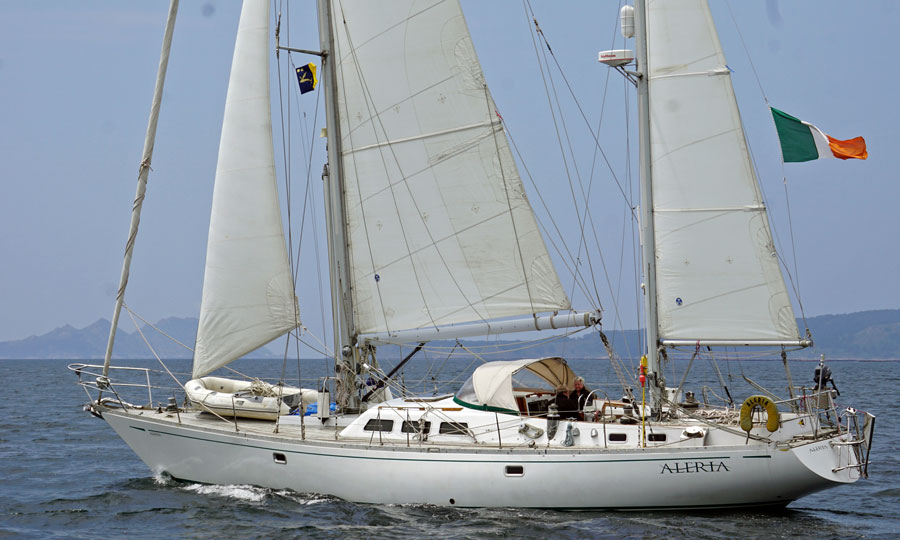
Is The Ketch Sailboat the Best Type of Sailboat for Offshore Cruising?
It's true that the ketch sailboat with its split rig can make an attractive cruising sailboat for a short-handed crew, but there is a downside to these types of sailboats
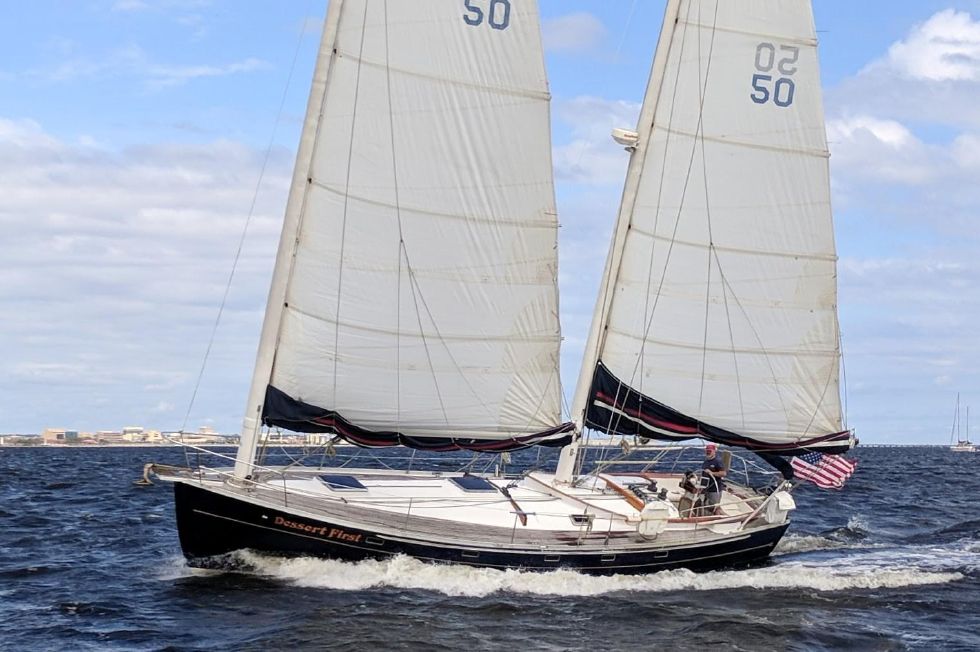
What Are Cat Ketch Sailboats and Do they Make Good Cruising Boats?
Seen alongside the complexity of a conventional sailboat, it's easy to imagine that the unstayed rigs of cat ketch sailboats represent the future for cruising sailboat designs.
Recent Articles
Amel Kirk 36 Sailboat Specs & Key Performance Indicators
Sep 07, 24 03:38 PM
Pearson 33 for sale
Sep 04, 24 03:29 PM
Apla 42 Sailboat Specs & Key Performance Indicators
Aug 30, 24 02:51 AM
Here's where to:
- Find Used Sailboats for Sale...
- Find Used Sailing Gear for Sale...
- List your Sailboat for Sale...
- List your Used Sailing Gear...
Our eBooks...

Cruising Boats...
Our ever-growing gallery of pics and basic specifications of many popular cruising boats...
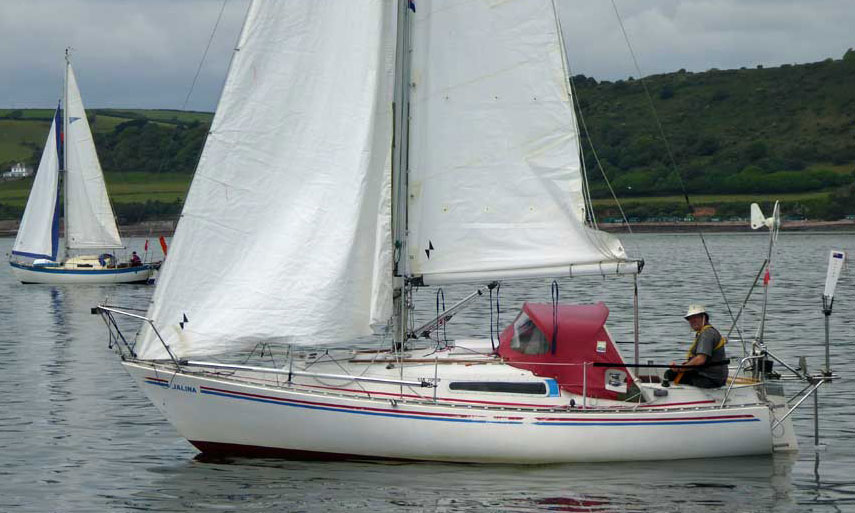
A few of our Most Popular Pages...

Copyright © 2024 Dick McClary Sailboat-Cruising.com
The Yacht Owner
Choose Smart for Happy Sailing!
Sloop – One of the Most Common Single Masted Sailing Boats
October 19, 2017 By Daniel Mihai Popescu Leave a Comment
The sloop is a sailing boat with a single mast and a fore-and-aft rig. It has only one head-sail: if a boat has two or more head-sails, it is named cutter, not sloop, and its mast may be set further aft than on a sloop. In Dutch they call it “sloep” , and in French it’s called “chaloupe” . The most common rig of modern sailboats is the Bermuda-rigged sloop. Typically, a modern sloop carries a mainsail on a boom aft of the mast, with a single loose-footed head-sail (a jib or a genoa jib) forward of the mast.
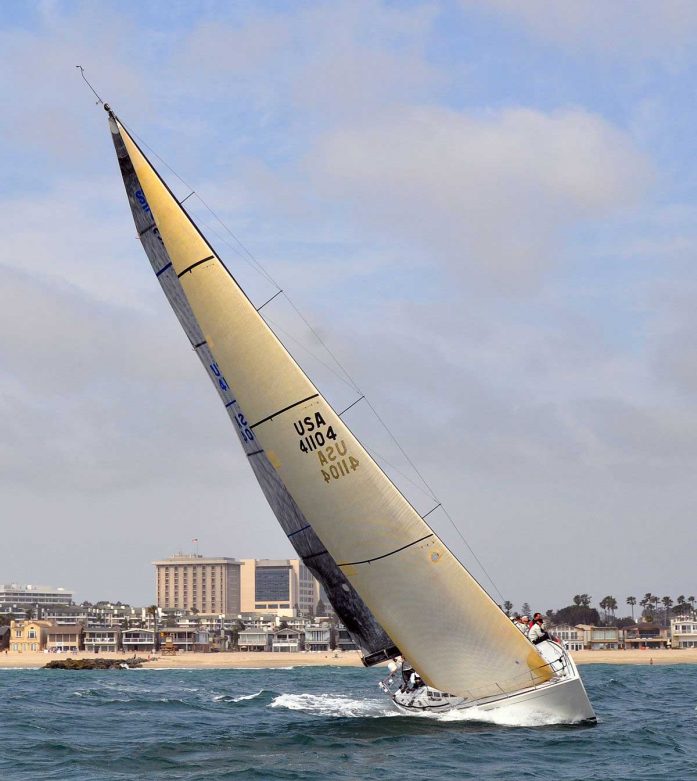
A sloop in Newport – photo by Don Ramey Logan
The Difference Between the Sloop and the Cutter
I have to start first with the “rig” term. As a noun, besides being a machinery designed for a special purpose, a rig is also the distinctive shape, number and arrangement of sails and masts of a ship. The sloop is considered the simplest and most popular rig today. The mast has to be placed one third forward and two thirds aft on a boat. If it is placed closer to the middle of the boat, this particular rig defines a cutter, which is very easy to be confounded. As already mentioned, the cutter has more than one head-sail.
The modern yachting sloop is known as the Bermuda sloop, due to its Bermuda rig, which is the optimal rig for upwind sailing; consequently sloops are popular with sport sailors and yachtsmen, and for racing. The rig is simple in its basic form, yet when tuned properly, it is maneuverable and fast. The main disadvantage is the relatively large size of the sails, especially on larger vessels. It is also less successful sailing downwind.
The Bermuda sloop is a type of fore-and-aft rigged sailing vessel developed on the island of Bermuda in the 17th century. In this sense, the term is applied to small ships, rather than boats. In its purest form, it is single-masted, although ships with such rigging were built with as many as three masts. Its original form had gaff rig, but evolved to use what is now known as Bermuda rig, making it the basis of nearly all modern sailing yachts.
This article was more than inspired from Wikipedia, but it’s less confusing.
If you like what you read, please subscribe to this blog by completing the form . If you want to help more, start by following us on Twitter , and like our page on Facebook . You don’t know what good things may happen. To lighten your day, check our pins on Pinterest , we can be friends there too. Oh, and if you need a really good looking blog attached to your site, or just for fun, to express your feelings more competitively, read this Own Your Website offer! Thank you very much.
Copyright © 2017 The Yacht Owner – Sloop – One of the Most Common Single Masted Sailing Boats
If you liked this article, tell someone about it

Follow Us on Twitter!
About Daniel Mihai Popescu
Daniel Mihai Popescu is a ship engineer with background in sea transportation, real estate, yacht brokerage, construction, entrepreneurship. Avid reader, traveled the world, explorer of the human nature. Never stopped learning, now I create and manage Wordpress based sites . • Twitter • Facebook • LinkedIn • Instagram • Pinterest • Goodreads • Medium •
Comment Policy : Be polite even if you disagree, and be nice and helpful if you can. Please use only your real name and don't post unrelated links in your comment. Keywords instead of your real name will be modified or the whole comment will be deleted as spam! As much as we want to help, only comments related to the subject are really appreciated. Using a non-existent e-mail address will lead to deleting the comment as well.
Leave a Reply Cancel reply
Your email address will not be published. Required fields are marked *
This site uses Akismet to reduce spam. Learn how your comment data is processed .
Gaff Rig Sloop: A Classic Sailboat Design Explained
by Emma Sullivan | Jul 28, 2023 | Sailboat Maintenance

Short answer gaff rig sloop:
A gaff rig sloop is a type of sailing vessel characterized by its triangular mainsail with a fore-and-aft rig. The mast is usually positioned further back on the boat compared to other sloops, allowing for a larger headsail. This traditional rig offers increased sail area and versatility while retaining simplicity in design.
Understanding the Gaff Rig Sloop: A Comprehensive Guide
By popular demand, we present to you a comprehensive guide on understanding the ever-charming and enigmatic Gaff Rig Sloop. From its rich nautical history to its unique sailing qualities, this blog post will leave no mast unturned in unraveling the mysteries of this fascinating sailboat.
But before we dive deep into the technicalities, let’s take a moment to appreciate the undeniable allure of the Gaff Rig Sloop. With its towering main mast adorned by an elegantly shaped gaff, this vessel carries a timeless beauty that can transport us back to a bygone era. It effortlessly evokes images of intrepid explorers setting sail towards distant shores, battling treacherous seas as they chase their seafaring dreams.
Now, let’s delve into the details of what sets apart the Gaff Rig Sloop from other sailboats.
Firstly, let us emphasize that the Gaff Rig Sloop is not for the faint-hearted. Its intricacy demands an experienced sailor who is willing to embrace and master its idiosyncrasies. But fear not! The satisfaction derived from conquering this mighty rig truly knows no bounds.
The key defining feature of the Gaff Rig Sloop is its beautiful gaff mainsail. This triangular sail’s upper edge peaks at the top of a tall main mast while being supported by a spar called a gaff running along its bottom edge. This configuration grants incredible flexibility in controlling sail shape through cunningham and throat halyard tension adjustments—a true playfield for those seeking complete control over their vessel’s performance.
Beyond aesthetics, this arrangement also boasts fantastic wind range adaptability. The adjustability provided by various halyards allows sailors to optimize their sails’ shape according to weather conditions – be it strong gusts or gentle breezes. Such versatility ensures both thrilling speed during lively regattas and soothing serenity during leisurely coastal cruises.
Now brace yourself as we share a little secret about the Gaff Rig Sloop – its ancestors were once the primary vessels for fishermen, securing their place in sailing history. This lineage gifted it certain invaluable characteristics still cherished today. The traditional tanbark coloring of gaff sails not only exudes nostalgia but also guarantees maximum UV resistance and durability – no wonder it has stood the test of time!
One can’t discuss Gaff Rig Sloops without touching upon their notable stability. Their relatively low center of effort, thanks to that magnificent gaff, enables them to remain steadfast even when stiff gusts attempt to knock them off course. It’s akin to having an old friend who constantly reminds you to stay grounded amidst tumultuous waters.
Beyond its captivating silhouette and impressive stability lies another advantage: Gaff Rig Sloops excel at downwind sailing! Boasting a larger sail area in comparison to Bermudan rigs, they effortlessly harness every breeze for exhilarating downwind runs. Now imagine surfing along with nature, feeling like a true master of the ocean as you ride those rolling swells!
In conclusion, understanding the Gaff Rig Sloop goes beyond deciphering technicalities; it’s an appreciation of tradition and timeless elegance melded with practicality and unrivaled sailing performance. So, whether you’re yearning for a taste of maritime nostalgia or seeking unmatched control over your vessel at sea, don’t shy away from embarking on this delightful adventure aboard a Gaff Rig Sloop!
How to Set up a Gaff Rig Sloop: Step-by-Step Instructions
Welcome to our detailed guide on setting up a Gaff Rig Sloop! If you’re a sailing enthusiast, or maybe just curious about the intricacies of rigging, this step-by-step explanation is here to provide you with all the information you need. So, grab your sails and join us on this insightful journey!
Step 1: Gathering the Necessary Equipment Before we start rigging our Gaff Rig Sloop, it’s important to assemble our toolkit. Ensure that you have all the required items at hand: mast, boom, gaff, halyard ropes, sail ties, main sheet blocks, and cleats. A well-prepared sailor is always one step ahead!
Step 2: Setting Up the Mast First things first – let’s raise the mast! Position it securely in its designated base and secure any supporting wires if necessary. Remember to check for proper alignment by using a spirit level; after all, we want our vessel standing tall and proud.
Step 3: Attaching the Halyard Lines Now that our mast stands firmly in place, it’s time to attach the halyard lines. These lines will hoist our sails into position. Attach one end of each halyard rope to their respective head of sail (main and jib), making sure they are securely fastened before moving on.
Step 4: Preparing the Gaff and Boom Assembly The gaff and boom are critical components in shaping your sails effectively. Securely attach them together using appropriate brackets or fittings provided by your manufacturer. Pay close attention to ensure everything is properly aligned; we don’t want any crooked sailors aboard!
Step 5: Raising The Main Sail Prepare yourself for some serious hauling – it’s time to raise the main sail! Take one end of your main halyard line and thread it through the head of your mainsail. Affix both ends of the halyard line firmly to your sail before proceeding. Pull upwards, gently at first, and gradually increase tension until your main sail reaches its rightful place atop the mast.
Step 6: Hoisting the Jib Sail With our main sail set, it’s now time to address the jib sail. Attach one end of the jib halyard rope securely to the head of your jib sail. Similar to the previous step, thread the other end through an appropriate block and then back down towards deck level for ease of operation. With a swift yet controlled motion, hoist your jib up into position until it flutters gracefully in harmony with your main sail.
Step 7: Tying Up Loose Ends – The Sail Ties Now that both sails are gloriously positioned and ready to catch that gentle breeze, let’s secure them using dependable sail ties. Wrap these handy little helpers around each furled section of sail and tie them tightly in place. This ensures our sails stay neatly stored when we need less wind power on our side.
Step 8: Directing Wind Power – The Main Sheet Blocks and Cleats As sailors, we must harness Mother Nature’s gift – wind! Our Gaff Rig Sloop gives us control over this force by employing a combination of main sheet blocks and cleats. Attach one end of your main sheet block system near the stern; then thread it through necessary blocks along boom length-wise for proper leverage. Finally, secure it to a sturdy cleat within easy reach for adjustments while sailing.
Congratulations! You’ve successfully rigged up your Gaff Rig Sloop! Now you’re well-equipped with this timeless design known for its classic elegance and versatility. Remember, practice makes perfect; be patient as you refine each step according to your vessel’s unique specifications and conditions.
So grab hold of those lines, feel the wind on your face, and enjoy sailing into uncharted waters with your newly rigged Gaff Rig Sloop!
Frequently Asked Questions about Gaff Rig Sloops Answered
Frequently Asked Questions about Gaff Rig Sloops Answered: A Detailed Professional, Witty, and Clever Explanation
Whether you are a sailing enthusiast or just curious about the nautical world, gaff rig sloops often raise questions among those interested in sailboats. In this blog post, we are going to provide you with detailed answers to some frequently asked questions about gaff rig sloops while infusing a touch of professionalism, wit, and cleverness into our explanations. So without further ado, let’s dive in!
Question 1: What is a gaff rig sloop? A gaff rig sloop is a type of sailboat that features a triangular jib at the front and a four-sided mainsail attached to a gaff spar. This traditional sail design offers excellent control and maneuverability while evoking nostalgia for maritime history. Picture yourself aboard one of these vessels as old salty dogs regale you with tales of seafaring adventures – ahoy!
Question 2: Why choose a gaff rig sloop over other sailboat designs? Well, my adventurous friend, if you prefer the romance of yesteryears when sails billowed on the horizon like white clouds, then the choice is clear. Gaff rig sloops provide an enchanting aesthetic reminiscent of bygone eras. Additionally, their versatile sail plan allows for easy adjustments and handling even in varying wind conditions.
Question 3: Are gaff rig sloops suitable for beginners? Indeed they are! While mastering any vessel takes time and practice, gaff rigs can be sailed by novices with relative ease. Their forgiving nature allows sailors to hone their skills without feeling overwhelmed by complicated sail controls found on modern rigs. So set your course for adventure; even landlubbers can find their sea legs on these delightful boats.
Question 4: How do I trim the sails on a gaff rig sloop? Trimming the sails on a gaff rig sloop requires a delicate balance between art and science. Adjusting the halyard and peak allows you to control the depth and shape of the sail, optimizing its efficiency. Think of it as sculpting the wind – finding that perfect harmony where nature’s breath fills your sails just right.
Question 5: What are some tips for maintaining a gaff rig sloop? Ah, now this is where cleverness comes into play. To keep your gaff rig sloop shipshape, regular inspections are key. Keep an eye out for chafed ropes or worn-out blocks; they’re like barnacles clinging to your vessel’s smooth lines. Don’t forget to treat wooden spars with love and care – just like you’d stroke a cat in front of a cozy fireplace.
Question 6: Are gaff rig sloops slower than modern rigs? While it’s true that gaff rigs might not match modern rigs in raw speed, what they lack in velocity they compensate tenfold in charm and gracefulness. Imagine gliding across blue waters, the gentle creaking of wooden spars harmonizing with lapping waves – an atmospheric symphony that will make you want to linger at sea forever.
Question 7: Can I race competitively with a gaff rig sloop? Oh, my competitive fellow sailor! Though more traditionally associated with leisurely cruising or coastal exploration, gaff rig sloops can certainly participate in regattas. Specialized racing events for classic yachts or historical replicas may showcase their elegance while emphasizing seamanship rather than pure speed. So hoist those sails high and show ’em what an old-world beauty can do!
In conclusion, gaff rig sloops offer sailors the chance to step back in time while enjoying the pleasures of navigating on water using traditional methods. They combine functionality with elegance and evoke a sense of adventure that modern sailboat designs often lack. So set sail on a gaff rig sloop, and may the wind be forever in your favor as you embark on unforgettable journeys!
The Fascinating History of the Gaff Rig Sloop
The gaff rig sloop, a captivating embodiment of nautical history, is an elegant sailing vessel that has intrigued seafarers for centuries. In this blog post, we will delve into the depths of its fascinating history, exploring the origins of this classic rigging system and the reasons behind its enduring popularity.
The story of the gaff rig sloop begins in the 17th century when it emerged as a refinement of earlier sail designs. The term “gaff” refers to a horizontal spar fixed to the mast at an angle, which supports the peak – or highest point – of the sail. This distinctive feature sets it apart from other sailing rigs and gives it a unique aesthetic appeal.
Initially used primarily by smaller vessels such as fishing boats and working craft, the gaff rig sloop gradually gained recognition for its exceptional versatility and maneuverability. Sailors quickly discovered that this rig allowed them to achieve higher speeds while maintaining excellent control over their vessels – a game-changer in terms of sailing tactics.
With time, these benefits caught the attention of racing enthusiasts looking to gain an edge on their competitors. Sailors realized that by adjusting various elements like mast height and sail material, they could optimize their vessel’s performance under different wind conditions. This adaptability cemented the gaff rig sloop’s reputation as a versatile and competitive choice for both racing and leisurely cruising.
One notable characteristic contributing to its success was its ability to carry multiple headsails – foresails positioned forward on either side of the bow. These additional sails enable sailors to maximize efficiency even further by harnessing varying wind flows around different points on their boat’s hull.
As technology advanced throughout naval history, new materials like synthetic fibers were incorporated into sailmaking processes. This evolution not only improved durability but also allowed for significant changes in design techniques. Nevertheless, many sailing enthusiasts remained attached to tradition and continued cherishing the elegance inherent in owning a gaff rig sloop.
Fast forward to the present day, and the allure of these beautiful vessels has not diminished. The timeless charm and nostalgia associated with gaff rig sloops make them sought-after by sailors seeking a connection to maritime history. Whether participating in traditional regattas or leisurely coastal cruising, enthusiasts are drawn to the way these rigs create a sense of oneness with the sea.
In conclusion, the fascinating history of the gaff rig sloop traces its roots back to the 17th century when it emerged as a refined sail design offering unparalleled speed and maneuverability. Its adaptability allowed for customization under different wind conditions, making it a favorite among competitive sailors. Over time, advances in sail technology brought changes to materials and techniques; nevertheless, many continued embracing this classic rig for its timeless appeal. Today, sailing enthusiasts appreciate gaff rig sloops for their nostalgic connection to maritime tradition, relishing their elegance as they navigate through scenic waters.
Mastering the Art of Sail: Tips for Sailing a Gaff Rig Sloop
Sailing is an incredible adventure that allows you to harness the power of the wind and navigate through vast bodies of water with grace and precision. While there are countless types of sailboats out there, one that stands out for its unique charm and challenging nature is the gaff rig sloop. Mastering the Art of Sail: Tips for Sailing a Gaff Rig Sloop will equip you with the knowledge and skills necessary to conquer the waves in this traditional vessel.
The gaff rig sloop is distinguished by its triangular mainsail, which is set on a mast that features two wooden poles known as gaffs. This classic design dates back centuries, capturing the essence of maritime history while offering an exhilarating sailing experience. However, don’t be fooled by its nostalgic appeal – sailing a gaff rig sloop requires finesse and attentiveness to fully embrace its potential.
To truly excel at sailing a gaff rig sloop, it’s essential to understand the unique characteristics and quirks of this vessel. Unlike modern sailboats with their sleek lines and streamlined designs, gaff rig sloops have a more traditional appearance combined with a centerboard or keel for stability. This combination demands a heightened level of skill when maneuvering in tight spaces or facing rough weather conditions.
One crucial tip for navigating a gaff rig sloop successfully is to master your sail trim. Due to its peculiar design, maintaining proper sail shape becomes even more critical than usual. A well-trimmed mainsail ensures optimum speed and balance in differing wind conditions while avoiding excessive heeling (when the boat leans excessively to one side). Adjusting both main halyard tension and boom vang tension will enable you to find that sweet spot where your sails are efficiently catching the wind without overpowering your vessel.
Another fundamental aspect essential to conquering the art of sail on a gaff rig sloop is understanding how to handle multiple sails effectively. In addition to the mainsail, which is regulated using the gaffs, these sloops often sport a jib or foresail. Coordinating the movement of two separate sails can be slightly more complex than maneuvering a single sailboat. Perfecting the art of balancing and coordinating these sails will allow you to maximize your vessel’s potential and make those breathtaking maneuvers with ease.
Furthermore, gaff rig sloops require a keen eye for wind shifts and sail adjustments. Being attentive to even the slightest variations in wind direction will help you anticipate changes in your vessel’s behavior and ensure that you remain on course. Quick reactions to gusts or lulls in the wind are key to maintaining momentum and avoiding any unintended deviations from your intended heading.
As with all sailing endeavors, safety should remain at the forefront of your mind when sailing a gaff rig sloop. These vessels may possess an undeniable old-world charm, but their traditional nature means that they might not have all the modern safety features found on newer boats. Familiarize yourself with basic safety procedures such as proper use of life jackets, understanding emergency signals, and having a comprehensive knowledge of navigational aids.
Mastering the art of sailing a gaff rig sloop is no small feat, but this unique experience is incredibly rewarding for those willing to take on the challenge. While it may involve enhanced expertise and careful navigation skills compared to other sailboats, there is something undeniably captivating about sailing through history itself.
So go ahead – embrace this timeless maritime adventure! Master the art of sail on a gaff rig sloop, dive into its rich history, tap into its raw power and elegance. With patience, practice, and an enthusiastic spirit, you’ll find yourself gliding effortlessly across vast waters while immersing yourself in an enchanting tapestry woven by centuries of seafaring tradition. Bon voyage!
Troubleshooting Common Issues with a Gaff Rig Sloop
Ahoy sailors and sailing enthusiasts! Today, we set sail on a journey to troubleshoot common issues that may arise with a gaff rig sloop. As sailors, we ride the waves with wind in our sails, but sometimes even the most experienced mariners encounter challenges along the way. Fear not, as we navigate through these troubleshooting tips with a touch of professionalism, wit, and cleverness.
1. Rigging Woes: The Standing Rigging Drama
One of the most common issues encountered aboard a gaff rig sloop is problems with the standing rigging. Over time, wear and tear can take its toll on these crucial components. To avoid any Shakespearean tragedy at sea, inspect your standing rigging regularly for signs of corrosion or damage. Remember that prevention is key – stay on top of routine maintenance to keep your rigging shipshape.
2. Sail Setbacks: The Perils of Hoisting
Hoisting those majestic sails can sometimes lead to unexpected setbacks. If you find yourself struggling to hoist your gaff sail smoothly, it’s time to channel your inner MacGyver and get creative! Check for any snags or obstructions that may impede your sail’s ascent; untangling lines and ensuring they are neatly coiled can work wonders. Don’t hesitate to call upon fellow sailors for an extra hand or two – teamwork makes the dream work!
3. Navigation No-No’s: Tangled Sheets
Picture this: you’re blissfully cruising along when suddenly you realize your sheets have tangled themselves into an intricate knot resembling a sailor’s labyrinthine nightmare. Take a deep breath and resist the temptation to dive headfirst into solving this obstacle blindly (quite literally). Instead, approach it systematically – identify which sheets are entwined and slowly work towards neatly untangling them block by block.
4. Boom Blunders: A Slapstick Comedy Act
Ahoy there! Are you experiencing an impromptu slapstick comedy act each time you gybe or tack? The boom swinging wildly, uncontrolled by any invisible hand? Firstly, make sure you and your crew are standing clear of the danger zone. Next, inspect the boom vang – a loose or improperly adjusted vang can contribute to this circus-like performance. Adjust it to keep that comedic mischief at bay and maintain control over your boom’s antics.
5. Reefing Repercussions: Reefing Gone Wrong
Reefing – the art of reducing sail area during strong winds – is essential for maintaining stability and safety on your gaff rig sloop. However, incorrect reefing techniques can lead to a heap of trouble in stormy seas. Remember that it’s better to be safe than sorry; reef early to avoid wrestling with unruly sails in unforgiving conditions. Properly securing your reefed sails using jiffy reefs or other reefing systems ensures efficient performance without compromising safety.
6. Mast Mania: Masthead Concerns
Ahoy landlubbers! While our masts may seem infallible, they are not immune to issues themselves. Keep a watchful eye on the masthead for any signs of wear or damage that may develop over time – think chafed lines, cracked hardware, or loose fittings. Regular maintenance includes reinforcing connections and ensuring proper tension throughout the rigging.
Navigating through these common issues with a gaff rig sloop requires both technical know-how and a touch of whimsy in equal measure. By combining professionalism with wit and cleverness, we can troubleshoot like true seafarers – turning obstacles into adventures and challenges into triumphs. So set sail with confidence my fellow mariners, armed with these troubleshooting insights as you conquer the open sea aboard your gaff rigged sloop!
Recent Posts

- Sailboat Gear and Equipment
- Sailboat Lifestyle
- Sailboat Maintenance
- Sailboat Racing
- Sailboat Tips and Tricks
- Sailboat Types
- Sailing Adventures
- Sailing Destinations
- Sailing Safety
- Sailing Techniques
- Search Please fill out this field.
- Newsletters
- Water Sports
Buying a Sailboat: Sloop vs. Ketch
Consider many different questions when deciding what kind of sailboat is best for you. If you are looking for a cruising sailboat, depending on your preferred size range, you may be choosing between a sloop and a ketch. These are the two most common types of cruising sailboats . Each offers certain advantages.
massmatt/Flickr/CC BY 2.0
A sloop is generally the most common type of sailboat rig. A sloop has a single mast and usually only two sails: the mainsail and a headsail, such as a jib or a genoa. A sloop may also use a racing or cruising spinnaker.
Sloops come in all sizes, from 8-foot dinghies to maxi boats over a hundred feet long. A sloop uses what is called a Bermuda or Marconi rig. This is the tall, thin, triangular mainsail that's commonly seen on the waters of popular boating areas.
The sloop rig generally is simpler to use and cheaper to build than a ketch rig. Because of the wind and sail dynamics involved, a sloop is almost always faster than other rigs in boats of comparable size, especially when sailing windward.
Jukka/Flickr/CC BY 2.0
A ketch is a common rig for cruising sailboats. It has two masts: a traditional mainmast as on a sloop, plus a smaller mast in the rear of the boat. This is called the mizzenmast. Technically, the mizzenmast must be mounted forward of the boat’s rudderpost to be a ketch. If the mizzen is mounted further aft, behind the rudder post, it is considered a yawl. The mizzenmast is typically smaller on a yawl than on a ketch, but otherwise, these rigs are similar.
A ketch, therefore, uses three primary sails: the mainsail and headsail, as on a sloop, plus the mizzen sail aft. A ketch may also use a spinnaker.
The three sails do not necessarily mean that the sail area on a ketch is larger than on a sloop of the same size, however. Sail area is usually planned by boat designers based on the boat's size, displacement (weight), hull shape and configuration, not on the number of masts or sails. This means that the mainsail and headsail of a ketch are generally smaller than on a sloop, but the mizzen sail roughly makes up the difference.
Benefits and Disadvantages of Sloops vs. Ketches
Gellinger/Pixabay/CC0 Creative Commons
Sloops and ketches each have their own benefits, but also disadvantages. When deciding what type of boat to buy, consider these differences.
Advantages of a Sloop
- A sloop is generally faster and sails closer to the wind.
- Sloops have fewer sails than ketches to buy and maintain.
- With a sloop, there is less standing and running rigging with one mast, which means there is less to manage and maintain overall.
- As the most popular contemporary boat, sloops are available in a wide variety.
Disadvantages of a Sloop
- Sloop sails are generally larger and heavier, requiring more strength for handling, hoisting, and trimming, particularly on a larger boat.
- Sloops have fewer options to reduce sail area in stronger winds. Sloops offer only reefing or furling of the sails.
Advantages of a Ketch
- Ketches have smaller sails. These sails are more easily managed and hoisted on a larger boat, which is why ketches are preferred by many older sailors.
- Using only two sails at a time provides multiple options for managing different sailing conditions, such as strong winds.
Disadvantages of a Ketch
- Ketch rigs generally do not sail as fast or as close to the wind as a sloop sailboat.
- Ketches have more standing rigging (shrouds and stays) and running rigging (halyards and sheets) to manage and maintain.
- The mizzenmast in ketches takes up space in the stern.
- There are fewer ketches available on the market. Ketches are more popular as an older boat.
Most ketches are intended as cruising boats that are easy to handle and comfortable for cruising. Many sloops, even sketch sloops, are designed for greater speed and racing. Many ketches, therefore, are different from sloops in ways other than just the masts and sails. Designed as cruisers, many ketches are heavier, more stable in sea conditions, and more commodious down below. On the other hand, contemporary builders produce few ketches, so there are a greater variety of sloops available as new boats.
As in other decisions when shopping for a sailboat, the preferable rig depends mostly on your preferred uses of the boat. The same is true when comparing fixed keel and centerboard sailboats.
Related Articles
More related articles.

- BOAT SHOWS , Cannes Yachting Festival , Engines , MOTOR BOATS , News , Premieres , SAILBOATS
AMEL 50: A REVOLUTIONARY SLOOP-RIGGED SAILBOAT
- August 30, 2017

Amel Yachts is used to launch new models only occasionally. The Super Maramu range, for example, was produced from 1988 until 2006, establishing itself as the symbol of the “ globetrotting boat” par excellence. If we also consider that the last Amel sloop-rigged cruising yacht was the Santorin in 1989, then it is clear that this brand-new Amel 50 represents a real revolution for the French yacht builder.

Consequently, the new Amel 50 seems to have been designed not only for the high seas and, for the first time, the shipyard has adopted less streamlined lines and a straight powerful bow alongside a midship beam which extends to the rear for better performance and great dimensional stability . As a natural result of the project, the stern houses two rudder blades , something completely new for Amel Yachts, that ensure greater manoeuvrability under sail.

Interiors, too, offer a further confirmation of Amel Yachts ‘s intention of penetrating new markets. On this yacht, space is proportionally the largest never seen on an Amel creation.
That’s probably for all these reasons that the new Amel 50 , although not officially presented yet, has already been nominated for the “ European yacht of the year ” in the “luxury cruiser” category.
The Amel 50 will be officially presented at the Cannes Yachting Festival next September. On that occasion, we will have the opportunity to enjoy a first sea trial and see if the French yacht builder has actually succeed in manufacturing a different boat without compromising the typical and unmistakable Amel spirit that has always made us love its beautiful creations.

https://www.facebook.com/tuttobarche/videos/1648544251831262/
Amel 50 – Technical Specifications
| Hull Length | 15.51 m |
| LOA | 14.51 m |
| Max Beam | 4.79 m |
| Width at waterline | 4.06 m |
| Draft | 2.15 m |
| Ballast | 5,36 t |
| Diesel engine power | 110 hp |
| Weight unloaded | 18.75 t |
| Displacement at full load | 2.,2 t |
| Fresh Water Tank Capacity | 600 l |
| Fuel Tank Capacity | 675 l |
| Mainsail | 62 m² |
| Genoa | 64 m² |
| Staysail (option) | 24 m² |
One Response
How is the boom traveler adjusted?
Leave a Reply Cancel reply
Your email address will not be published. Required fields are marked *
Save my name, email, and website in this browser for the next time I comment.
Language switcher
Browse categories.

You might be interested in
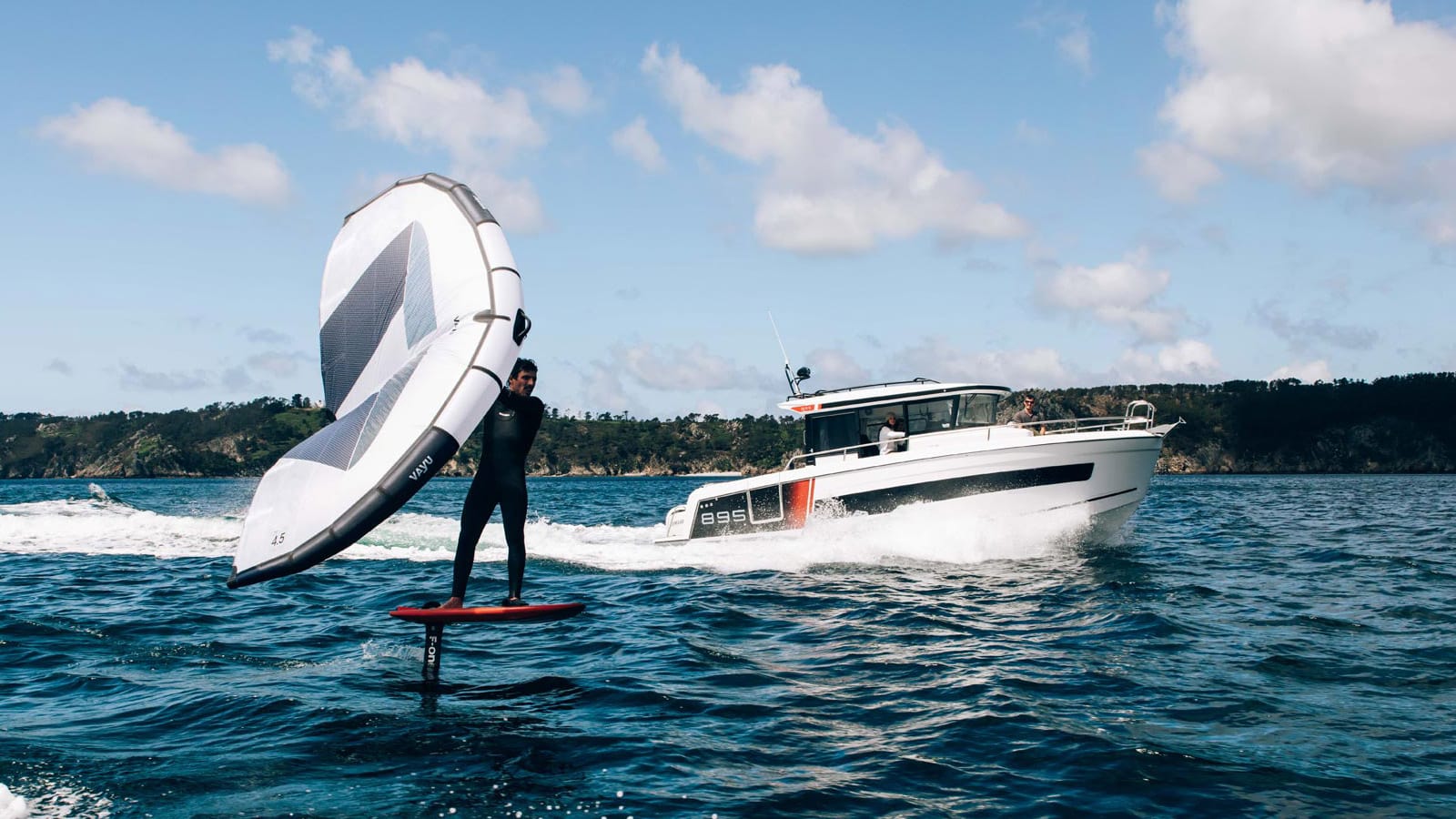
Jeanneau conquers new markets: all the latest additions from Cannes 2024
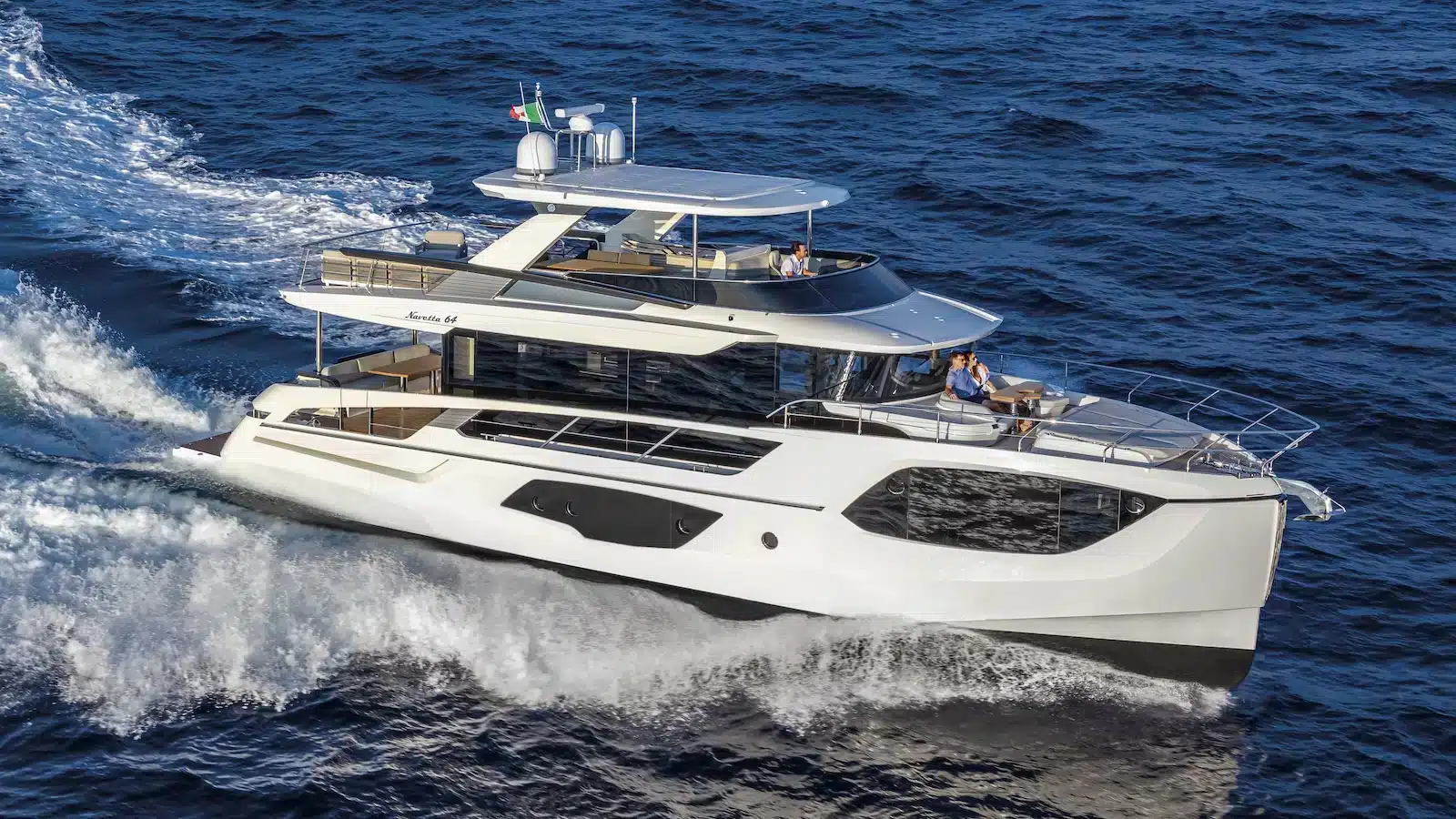
Absolute Yachts at Cannes with a contemporary and innovative collection
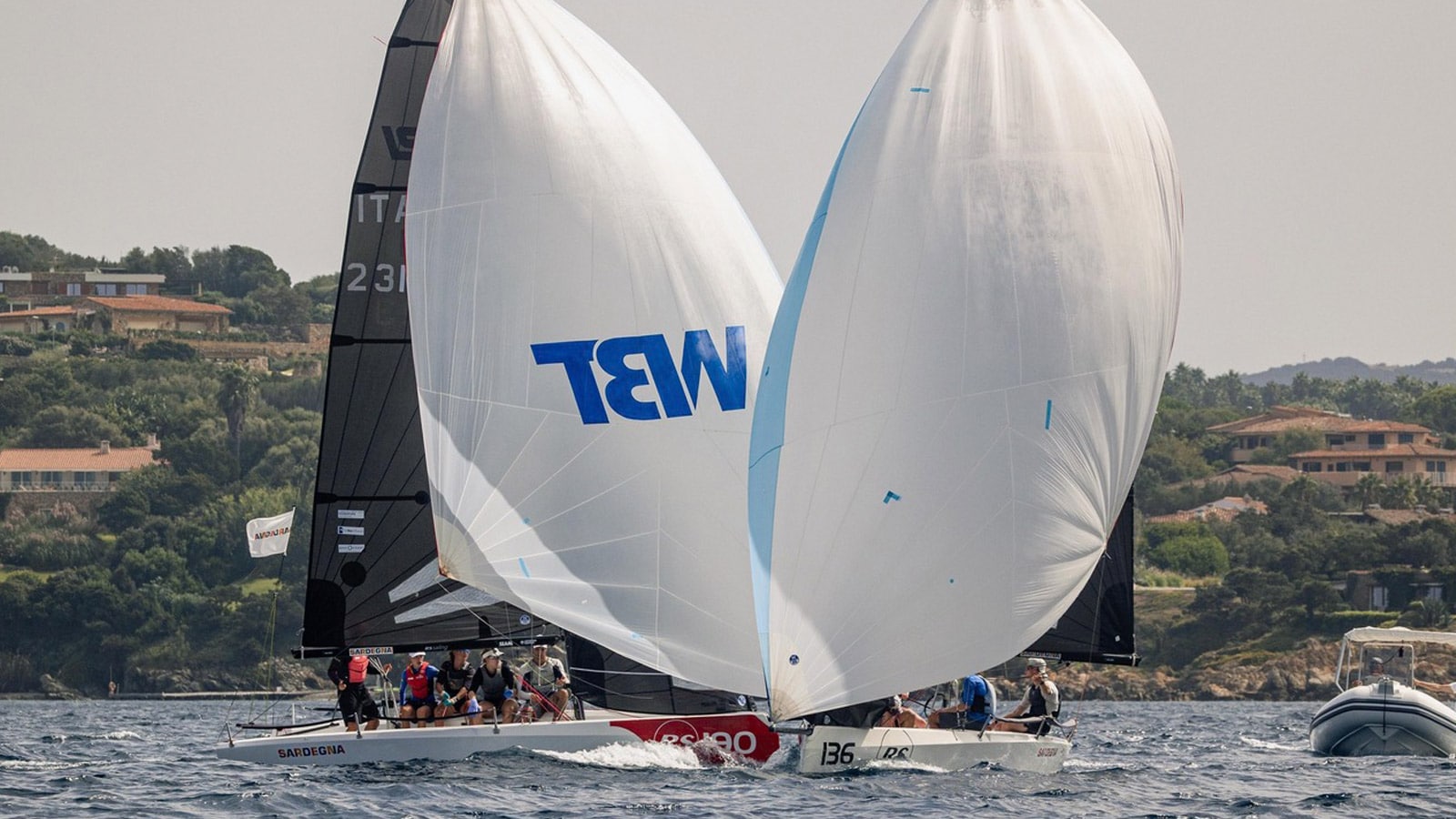
Innovative Sailing World Championship: English crew triumphs
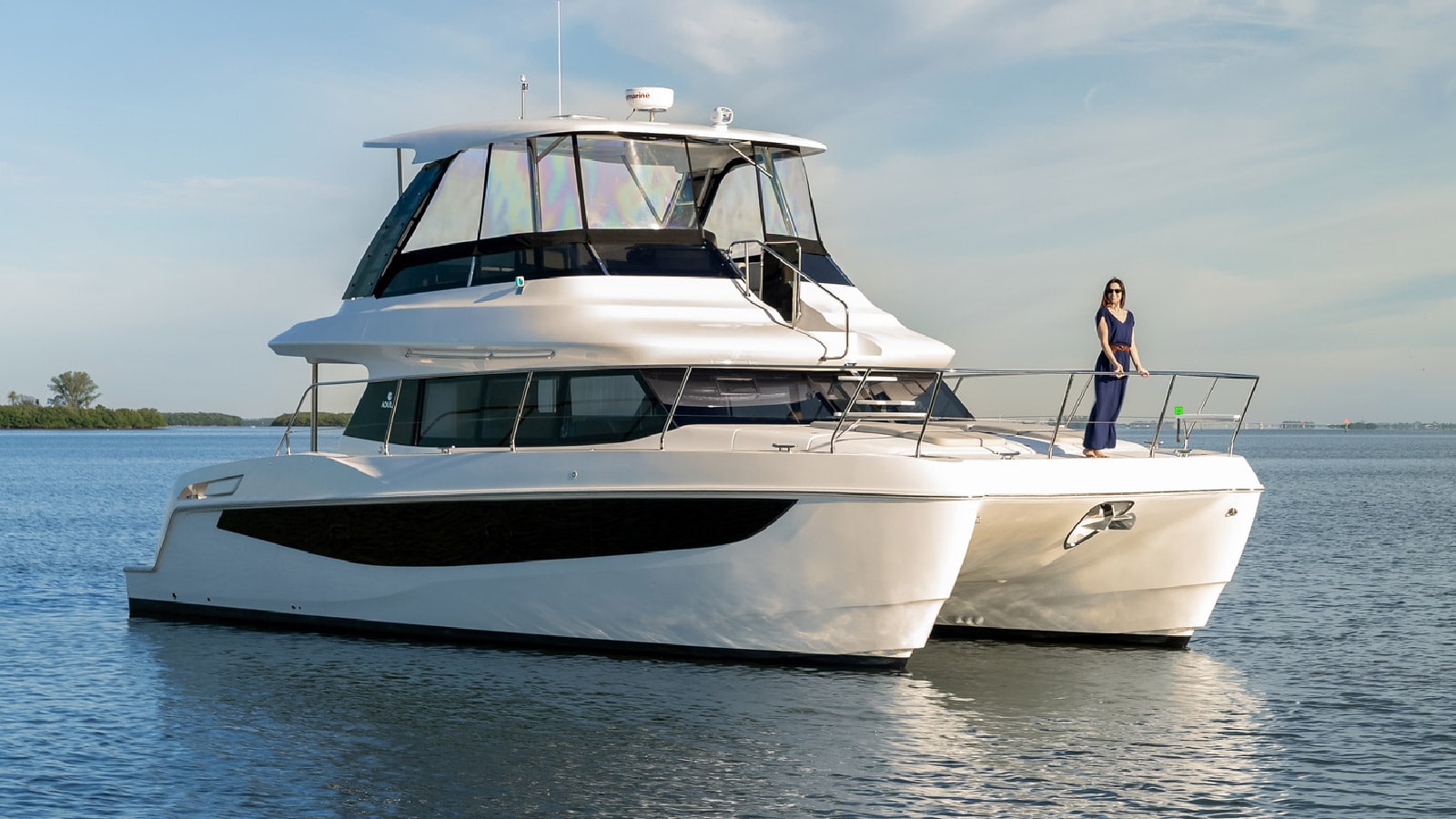
Aquila Power Catamarans conquering Cannes

© 2021 – THE INTERNATIONAL YACHTING MEDIA Designed by BLive Communication
ABOUT YACHTINGNEWS.COM
Yachting News is an interactive multimedia magazine dedicated to the world of boating.
The International Yachting Media is the worlds most widely read boating magazines network. Whit its portal It broadcast its original contents in five languages and in more than 200 countries developing 950,000 views a week. Our web portals are the main source of information for yacht and boat owners, the place where they can find anything about their boating passion.
THEINTERNATIONALYACHTINGMEDIA.COM | SUPERYACHTS.NEWS | YACHT DIGEST
VIRTUAL BOAT SHOW | TUTTTOBARCHE | TOUSLESBATEAUX | TODOSLOSBARCOS
BOATING NEWS FREE APP

To provide the best experiences, we and our partners use technologies like cookies to store and/or access device information. Consenting to these technologies will allow us and our partners to process personal data such as browsing behavior or unique IDs on this site and show (non-) personalized ads. Not consenting or withdrawing consent, may adversely affect certain features and functions.
Click below to consent to the above or make granular choices. Your choices will be applied to this site only. You can change your settings at any time, including withdrawing your consent, by using the toggles on the Cookie Policy, or by clicking on the manage consent button at the bottom of the screen.
Subscribe For Latest Updates
Sign up to receive the best of Yachting News, sea trials, boat review and world premieres .
The only ADVERTISING FREE newsletter

IMAGES
VIDEO
COMMENTS
What is a sloop rig? A sloop rig is a sailboat with one mast and two sails: a mainsail and headsail. It's a simple sail plan that handles well and offers good upwind performance. The sloop rig can be sailed shorthanded and is able to sail very close to the wind, making it very popular. Most recreational sailboats use a sloop rig.
A sloop rigged sailboat refers to a popular type of sailing vessel with one mast and two sails - a mainsail located at the rear (aft) of the mast and a headsail at the front (forward). This configuration allows for efficient wind capture and provides great maneuverability in different wind conditions. 2) The Main Components:
Gaff rigged sloop, 1899. A sloop is a sailboat with a single mast [1] typically having only one headsail in front of the mast and one mainsail aft of (behind) the mast. [note 1] Such an arrangement is called a fore-and-aft rig, and can be rigged as a Bermuda rig with triangular sails fore and aft, or as a gaff-rig with triangular foresail (s ...
Learn about the sloop rig, a single-mast and fore and aft sail configuration that is popular for recreational sailing. Find out the advantages, disadvantages and variations of this rig, and see examples of sloop sailboats.
Learn about the six rig types seen on yachts, from the most popular sloop to the least common cat. Find out the advantages and disadvantages of each rig, and how they affect sailing performance and appearance.
Learn about the cutter rig, a variation of the sloop with two headsails, the yankee and the staysail. Find out why it is a popular choice for offshore sailing and how it differs from the sloop in tacking and balance.
Sloop rigging refers to the configuration of a sailboat 's mast, boom, and sails. In a traditional sloop rig, there is a single mast located at the front of the boat called the mainmast, and it carries one mainsail. The mainsail extends from the top of the mast to the boom, which is attached near its bottom end.
Bermuda Sloop: the most common rig. Most modern small and mid-sized sailboats have a Bermuda sloop configuration. The sloop is one-masted and has two sails, which are front-and-aft rigged. This type of rig is also called a Marconi Rig. The Bermuda rig uses a triangular sail, with just one side of the sail attached to the mast.
A sloop is a type of sailboat that has a single mast and a fore-and-aft rig. This means that the sails are positioned parallel to the length of the boat, making it easier for sailors to control the direction of the boat. The simplicity and versatility of the sloop rig make it one of the most popular sailboat rigs in use today.
The Bermuda rig is popular for its ability to sail efficiently into the wind, its simplicity, and ease of handling, making it well-suited for a wide range of sailing activities. Gaff Rig. Another sloop rig variation is the gaff rig, which features a four-sided mainsail supported by a spar, known as the gaff, near its upper edge.
We offer the cutter rig on all our modern offshore cruising yachts from the Rustler 37 (shown) upwards. For a cutter to work efficiently, the base of its foretriangle needs to be a minimum of around 4.25m (14ft). The deck must be strongly reinforced, and it may need some supporting structure beneath it, to take the loads from the inner forestay.
Know-how: Modern Rigs 101. Peter Nielsen. Updated: May 20, 2024. Original: Mar 5, 2020. This classic Sabre carries the kind of masthead rig typical of its era; note how the large genoa sheets outside the shrouds (left); This X-Yachts performance-cruiser provides an excellent example of a modern fractional rig; note the narrow headsail (right ...
June 17, 2024. Sailboats are powered by sails using the force of the wind. They are also referred to as sailing dinghies, boats, and yachts, depending on their size. Sailboats range in size, from lightweight dinghies like the Optimist dinghy (7'9") all the way up to mega yachts over 200 feet long. The length is often abbreviated as LOA (length ...
Find Sail Sloop boats for sale in your area & across the world on YachtWorld. Offering the best selection of boats to choose from. ... Sloops date all the way back to the 17 th century, offering a sailboat rig that is popular because it can easily head up winds and is ideal for short-handing thanks to its simple controls. As recreational ...
Cruising sailors once upon a time preferred such rigs, at least on larger cruising boats, because each separate sail requiring handling was smaller and thus more manageable. These days, however, by far the most popular rig for both racing and cruising sailboats is the simple sloop rig. This has a single mast supporting a single Marconi mainsail ...
The Modern Sloop. The most common type of small-to-midsize sailboat is the sloop. The rig is one mast and two sails. The mainsail is a tall, triangular sail mounted to the mast at its leading edge, with the foot of the sail along the boom, which extends aft from the mast. The sail in front called the jib or sometimes the headsail, mounts on the ...
Low Aspect Ratio - better off the wind. Sailing sloops with moderate rigs though, are probably the most popular of all cruising sailboats. With just a single mast, two sails (a foresail or headsail, and a mainsail) and the minimum of rigging and sail control lines they are relatively simple to operate and less expensive than two-masted ketch rigs.
Short answer: Fractional sloop. A fractional sloop is a type of sail rig used on sailboats. It involves having the forestay attached at a point lower than the mast head, resulting in a smaller jib and larger mainsail. This configuration offers better control and balance in varying wind conditions, making it popular among racing and cruising boats.
Sloop, Cutter, Ketch, and Yawl are the 4 most common types of sailboats. This video discusses the advantages and disadvantages of each.NOTE: There is an erro...
The sloop is a sailing boat with a single mast and a fore-and-aft rig. It has only one head-sail: if a boat has two or more head-sails, it is named cutter, not sloop, and its mast may be set further aft than on a sloop. In Dutch they call it "sloep", and in French it's called "chaloupe". The most common rig of modern sailboats is the ...
A gaff rig sloop is a type of sailing vessel characterized by its triangular mainsail with a fore-and-aft rig. The mast is usually positioned further back on the boat compared to other sloops, allowing for a larger headsail. This traditional rig offers increased sail area and versatility while retaining simplicity in design.
A sloop is generally the most common type of sailboat rig. A sloop has a single mast and usually only two sails: the mainsail and a headsail, such as a jib or a genoa. A sloop may also use a racing or cruising spinnaker. Sloops come in all sizes, from 8-foot dinghies to maxi boats over a hundred feet long. A sloop uses what is called a Bermuda ...
The Super Maramu range, for example, was produced from 1988 until 2006, establishing itself as the symbol of the "globetrotting boat" par excellence. If we also consider that the last Amel sloop-rigged cruising yacht was the Santorin in 1989, then it is clear that this brand-new Amel 50 represents a real revolution for the French yacht builder.